Asia is the largest continent in both size and population. It covers about 30 percent of the world’s land area and has about 60 percent of its people. Asia extends from Africa and Europe in the west to the Pacific Ocean in the east. The northernmost part of the continent lies within the frozen Arctic. But in the south, Asia ends in the steaming tropics near the equator.
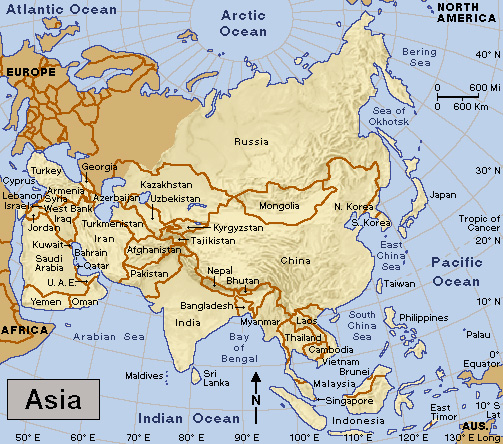
Asia has some of the world’s longest rivers, largest deserts, and thickest forests and jungles. The highest and lowest places on Earth are in Asia. Mount Everest, the highest, rises 29,032 feet (8,849 meters) above sea level along the Nepal-Tibet border. The Dead Sea shore, the world’s lowest land, lies about 1,411 feet (430 meters) below sea level between Israel and Jordan.
The 50 countries of Asia include some of the world’s largest and smallest countries in population. India, the world’s most populated nation, has about 1 1/2 billion people. But about 25 percent of Asia’s countries have populations of less than 5 million people.
Asia also contains some of the world’s largest and smallest countries in area. Russia, which lies partly in Europe but mostly in Asia, is the world’s largest country in area. It covers more than 6 1/2 million square miles (17 million square kilometers. But three Asian nations—Bahrain, the Maldives, and Singapore—each cover less than 400 square miles (1,000 square kilometers).
The nations of Asia have a variety of political systems. Different types of Communist governments rule China, North Korea, and Vietnam. Such nations as Bhutan and Saudi Arabia have kings. Sheikhs control Bahrain, Qatar, and the United Arab Emirates. Asian nations that operate under democratic principles include India, Israel, and Japan. Military leaders have taken control of many Asian countries in times of trouble.
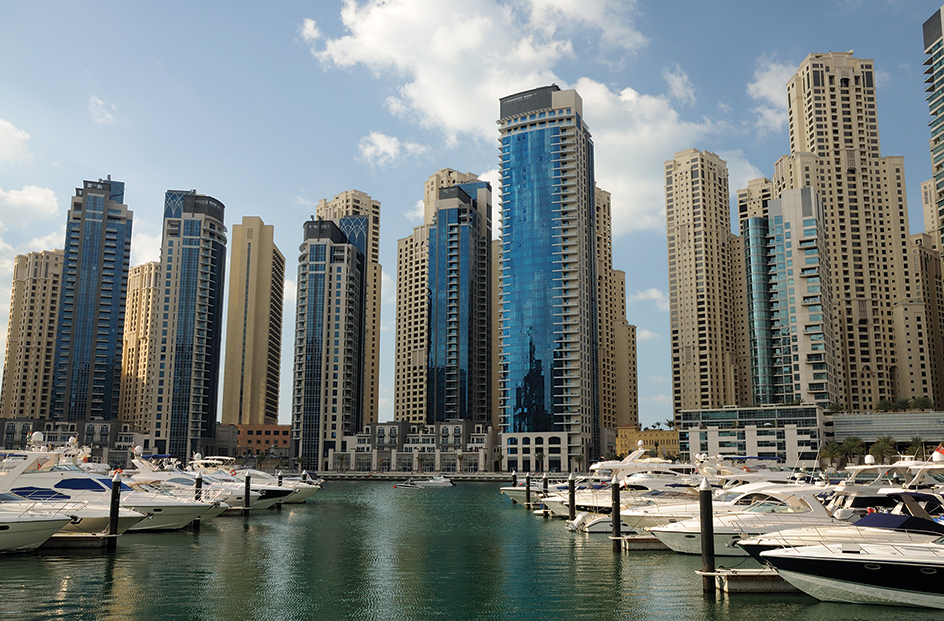
The people who inhabit Asia are as varied as everything else about the continent. The people differ greatly in their ancestry, customs, languages, religious beliefs, and ways of life. Because of these differences, this article discusses the life of the people of Asia in six separate Way of life sections. The article also describes the land, climate, animals, plants, agriculture, and industry of Asia. A final section traces the history of the continent.
Civilization in Asia began about 5,500 years ago, long before it began in Europe. During ancient and medieval times, Asia moved ahead of Europe in economic, cultural, and scientific development. Asians founded the first cities, set up the first systems of law, and became the first farmers and merchants. Asians invented writing and created the earliest literatures. All the world’s major religions originated in Asia. In addition, Asians invented paper, the magnetic compass, and movable type.
In the 1500’s and 1600’s, Europeans began to establish trading outposts in Asia, some of which gradually became colonies. From about 1750, Western European nations began conquering large parts of Asia.
In the 1800’s, when the European colonizers ruled much of Asia, the economic gap between Asia and the West widened. The European colonies in Asia became sources of raw materials to fuel development for European industry. The colonies served as markets for European manufactured products. They also began commercial production for the European market. Asian nations remained largely agricultural, and their farmers continued to use traditional tools and farming methods. Almost all colonial Asia gained independence during the mid-1900’s.
After World War II (1939-1945), Asia became a center of the struggle between Communist and non-Communist countries, and fighting broke out in many Asian nations. The Communists succeeded in China and Vietnam, and achieved partial success in Korea.
Tensions between the Communists and their democratic rivals have eased in some places, but remain high in others. The non-Communist Chinese Nationalists retreated to the island of Taiwan. Today, China and Taiwan struggle over the issue of Taiwanese independence. Korea was divided into Communist North Korea and democratic South Korea. The two sides never signed a formal truce, and a 487-square-mile (1,262-square-kilometer) barrier called the Demilitarized Zone (DMZ) still divides them.
Other disputes have brought about fighting between many groups of people in Asia. For example, India and Pakistan have never resolved which country controls the territory of Kashmir. As a result of such disputes, some areas of Asia almost continually face wars and threats of wars while trying to solve their other problems.
Meanwhile, a worldwide population explosion sent the number of people in Asia and elsewhere soaring. The growing populations created a need for more food, jobs, schools, and other necessities. In the 1960’s, there were fears that food production could not keep up with Asia’s rapidly growing population. However, family planning policies in some countries helped to curb population growth, and the introduction of new farming technologies increased agricultural production. Slowing population growth, improving agriculture, and increasing industry have raised living standards. Beginning in the 1980’s and 1990’s, increased foreign investment in the industries of China, India, and other Asian nations has greatly improved their economies.
People
Over 43/4 billion people, or about 60 percent of the world’s population, live in Asia. India has more people than any other country in the world, and China has the second largest population. More than one-third of all the people in the world live in these two countries.
This section gives a broad overview of the population distribution in Asia. It also discusses, in general terms, Asia’s ethnic (cultural) groups, religions, and languages. The article’s six Way of life sections then provide more detailed information about Asian peoples who live in various regions of the continent.
Population distribution.
If Asia’s people were distributed evenly throughout the continent, there would be 283 per square mile (109 per square kilometer). But many areas are so cold, so hot, so dry, or so mountainous that few people live there. The vast majority of Asians live in river or mountain valleys or near seacoasts, where many of them live by farming or fishing. 
Victoria Harbour
Parts of Asia rank among the world’s most densely populated areas. They include Bangladesh; Hong Kong, Macau, and eastern China; Singapore; the Ganges Valley of India; most of Japan; and the island of Java in Indonesia. In these regions, millions of people pack the big cities. Even many rural areas in these places are densely populated.
Peoples of Asia.
The peoples of Asia have rich and varied cultures and ancestries. Asia has dozens of ethnic groups—both large and small. A single country may have several groups. The largest ethnic groups on the continent include the Arabs of Southwest Asia and the Chinese of East Asia.
The members of an ethnic group may be united by language, religion, common ancestry, or other characteristics. Ethnic groups establish rules of conduct for their members and preserve artistic, religious, and other traditions. Many members of ethnic groups feel a strong sense of identification or belonging.
Asia has often been divided by religious and ethnic tensions. Sometimes, these tensions have led to violent conflict. For example, there have been wars between Arabs and Jews, Greeks and Turks, Hindus and Muslims, and Armenians and Azerbaijanis. Some conflicts arise from a minority religious or ethnic group’s desire to achieve self-determination within a country. In other cases, the conflict is between two or more countries.
Religions.
All the world’s major religions began in Asia—Buddhism, Christianity, Confucianism, Hinduism, Islam, and Judaism. The history and beliefs of these religions are discussed in separate articles and in the Religion article.
More Asians practice Hinduism than any other religion. Hinduism is the major faith in India and Nepal. 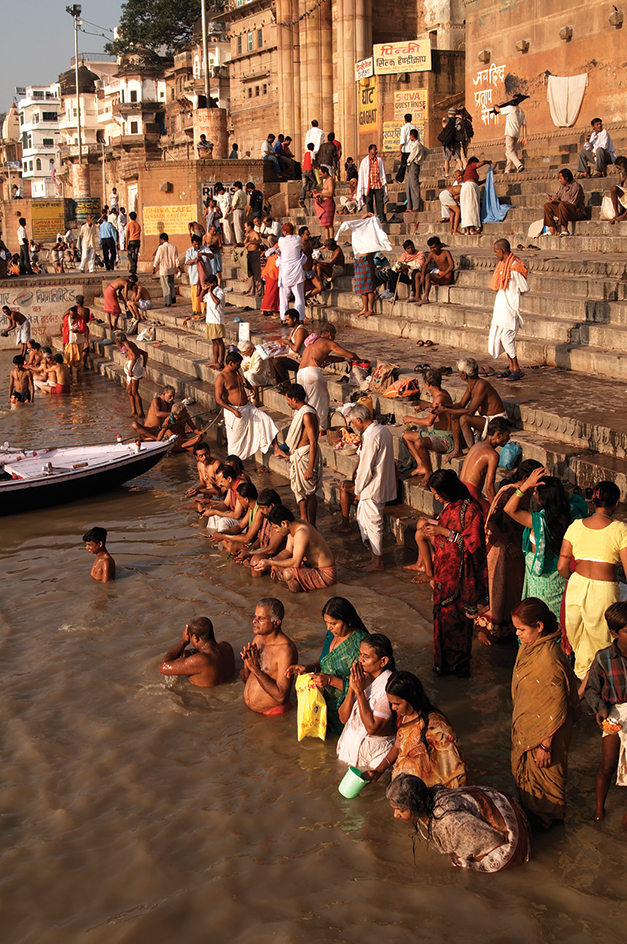
Islam has the second largest number of Asian followers. Geographically, it is the most widespread religion on the continent. In Southwest Asia, in much of Central Asia, and in such countries as Bangladesh, Indonesia, and Pakistan, most of the people are Muslims (followers of Islam).
Buddhism is the chief religion of mainland Southeast Asia and also has many followers in East Asia. Lamaism, a branch of Buddhism, is the chief religion of Mongolia and other parts of Central Asia. Confucianism and Taoism (also spelled Daoism) also have many followers in China, and Shinto is important in Japan. Many Asian people combine Buddhism with one or more of these other beliefs.
Most people in Cyprus and the Philippines and many in Lebanon, Armenia, Georgia, and Russia practice Christianity. It is also spreading quickly in China. Judaism is the chief religion in only one nation—Israel.
Languages.
The many languages and dialects (local forms of languages) spoken in Asia present a major barrier to communication. In some parts of the continent, the people of one village cannot speak to their neighbors in a village a few miles away. For example, in Madhya Pradesh, one of India’s states, the people speak more than 375 languages and dialects.
Arabic and Hebrew, the chief languages of far southwestern Asia, belong to the Afro-Asiatic family of languages. Russian and the chief languages of Afghanistan, northern India, Iran, Pakistan, and Sri Lanka are Indo-European languages. The major languages of southern India are in the Dravidian family. Languages of the Uralic and Altaic families are spoken in Kazakhstan, Mongolia, Siberia, Turkey, Turkmenistan, and Uzbekistan. Some linguists include Japanese and Korean in the Altaic family. Chinese is the major language of the Sino-Tibetan family, which also includes Burmese, Lao, Thai, and Tibetan.
Such southeastern Asian languages as Khmer and Vietnamese are in the Mon-Khmer family. Most people on Southeast Asian islands speak Austronesian languages, including Indonesian, Malay, and Filipino. See Language (Language families).
Way of life in Southwest Asia
Southwest Asia covers about 2,755,000 square miles (7,137,000 square kilometers), or 16 percent of the continent. It includes the 7 nations of the Arabian Peninsula and 12 nations north and east of the peninsula.
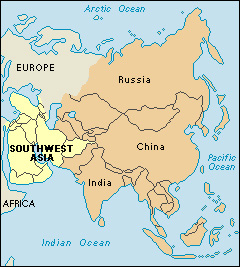
Saudi Arabia, which is the region’s largest nation in size, covers about two-thirds of the Arabian Peninsula. The other peninsular nations are Bahrain, Kuwait, Oman, Qatar, the United Arab Emirates, and Yemen. The nations that lie outside the peninsula include Afghanistan, Armenia, Azerbaijan, Cyprus, Georgia, Iran, Iraq, Israel, Jordan, Lebanon, Syria, and Turkey. Small parts of Azerbaijan, Georgia, and Turkey are in Europe, but these countries lie mainly in Asia. Southwest Asia also includes the Sinai Peninsula, which is the northeast corner of the African country of Egypt; and the disputed regions known as the Gaza Strip and the West Bank.
Desert covers much of Southwest Asia. Little rain falls, and water is scarce in most of the region. Even so, many Southwest Asians work on farms. The farmers live crowded together along the seacoasts and in river and mountain valleys, which have enough water for growing crops. The region’s deserts are thinly populated. Southwest Asia has a population density of only 156 persons per square mile (60 per square kilometer). 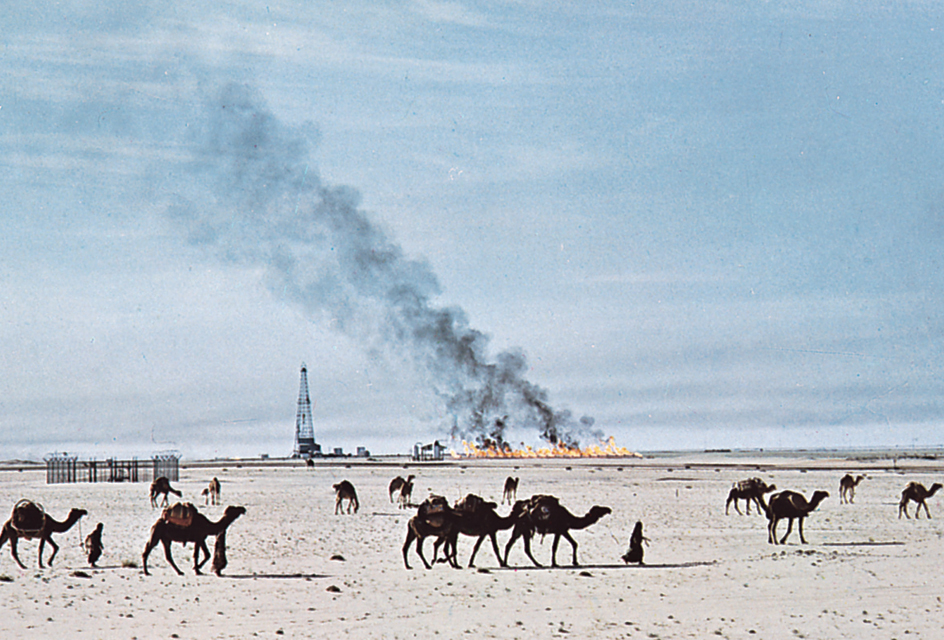
A shortage of good farmland and a lack of big industrial cities in most of Southwest Asia have made economic progress difficult. But the land—even the desert—holds hope for the future. It yields huge quantities of oil, the region’s most valuable natural resource. Southwest Asian governments use some of the oil income to fight poverty. They also work to increase farm production and to bring industry to their nations. Rapid population growth has forced many countries of the region to import much of their food.
The people.
About 430 million people, or 9 percent of all Asians, live in Southwest Asia. Members of the Arab ethnic group make up the majority of the population in 11 of the 19 Southwest Asian nations. These 11 nations are the 7 of the Arabian Peninsula, plus Iraq, Jordan, Lebanon, and Syria. The millions of Arabs throughout Southwest Asia and North Africa are united by language (Arabic), religion (Islam), and cultural and historical background.
The first Arabs lived on the Arabian Peninsula and in nearby areas in ancient times. The Islamic prophet Muhammad was an Arab who died in A.D. 632. His followers spread Islam, the Arabic language, and the Arab way of life to many lands.
Israel, most of whose people are Jews, lies among the Arab countries. Like the Arabs, Jews have lived in Southwest Asia since ancient times. Through the years, many Jews settled in Europe, North America, and other parts of the world. In the late 1800’s, Jews began a movement to reestablish a homeland in Southwest Asia. This movement led to the founding of Israel in 1948. The Arabs opposed the creation of a Jewish nation in what they considered Arab land. Ever since, the Arabs and Israelis have quarreled and fought. Conflicts have also erupted between various Muslim groups and between Muslims and Christians. Southwest Asia remains one of the world’s chief trouble spots.
The Arabs and Jews of Southwest Asia speak languages in the Semitic group of the Afro-Asiatic language family. Arabs speak Arabic, and Jews speak Hebrew. People in the countries of northern Southwest Asia—Afghanistan, Armenia, Azerbaijan, Cyprus, Georgia, Iran, and Turkey—speak Indo-European and Turkic languages. The ancestors of the Afghans, Azerbaijanis, Iranians, and Turks came mainly from Central Asia. The Armenians and Georgians are descended from ancient peoples of the Caucasus Mountain region. About 80 percent of the people on the island of Cyprus are Greeks, and Turks make up the other 20 percent of the island’s population.
Religions.
Christianity, Islam, and Judaism began in Southwest Asia. Today, the majority of people in most of the Southwest Asian nations practice Islam. However, Christianity is the chief religion of Armenia, Cyprus, and Georgia. Judaism is the chief religion of Israel.
Country life.
About a fourth of Southwest Asia’s people work on farms. Also, thousands of nomads move through the deserts and mountains of Asia herding camels, goats, and sheep. Most farmers and nomads follow ways of life that have roots deep in the past. Many people wear clothing similar to that of their ancestors. For example, many Arab men wear long, flowing robes and a draping cloth that covers the head and neck.
Like their ancestors, most of the farmers do not own the land they work. Instead, they rent it from wealthy landlords or the state. Machinery is gradually replacing traditional tools, and farmers grow cash crops in addition to crops for their family. Farm families eat foods made from such grain crops as barley and wheat. Other important foods include dates, olives, and other fruits.
Some Southwest Asian farmers live on the outskirts of urban areas. Many others live in small villages near the land they work. A typical village consists of about 50 houses crowded together along narrow streets. Dried mud and adobe are traditional building materials, but modern materials are increasingly used. Some villages have a public bathhouse, and a teahouse where men gather to discuss community affairs. But many villages have only one public building—a mosque (Islamic house of worship). 
Southwest Asian nomads rely almost entirely on their animals for the necessities of life. They live in tents made from camel or goat hair. Their food includes cheese, meat, and milk, all of which come from their animals. Many nomads make their clothing from animal hair and skins. The nomads move about, looking for pasture for their herds. Occasionally—perhaps once a year—a nomad visits a city or town to sell cheese, meat, skins, and wool and to buy supplies. The number of nomads has declined as many have settled in villages and towns, sometimes under pressure from their governments.
Many rural Southwest Asian women—especially Arab women—remain at home most of the time, as their female ancestors did. These women both keep house and take part in outdoor chores, such as harvesting crops or milking animals. When they appear in public, they cover their faces with a veil.
Social relationships in rural Southwest Asia are also based on traditions. Most farm and nomad families live in extended families. Grandparents, parents, unmarried children, and married sons and their families all live together. The oldest male in the family has authority over the rest of the family. He also has the responsibility for the well-being of the entire group.
Outside the family, a farmer’s strongest ties are to the village, and a nomad’s are to the tribe. A chief and a council of elders govern most villages. These officials settle disputes between families. Most nomad tribes consist of many families related on the male side. The tribal leader, called a sheikh in Arab countries, is usually the wealthiest member of the group. The leader settles disputes between families and often provides aid for needy members of the tribe.
In the past, many farmers and most nomads had little or nothing to do with their national government. They viewed government officials as outsiders without power in village or tribal matters. Many Southwest Asian governments have worked to establish more contact with their rural people and to teach modern agricultural techniques to farmers. They have also established schools and medical clinics in rural communities.
In rural Southwest Asia, radios and televisions have become more common. However, in these remote corners, people must use satellite dishes to receive TV signals beamed from satellites high above Earth.
Rural life in Israel differs greatly from that in other nations of Southwest Asia. Many Israeli farmers live in a collective community called a kibbutz, in which the farmers share all property and combine their labor. Other Israeli farmers belong to a cooperative community called a moshav. On a moshav, the farmers own their own land and homes but purchase equipment and other goods as a group. See Israel (Agriculture).
City life.
Since the 1950’s, the cities of Southwest Asia have grown tremendously. The three largest cities of Southwest Asia are Baghdad, Iraq; Tehran, Iran; and Istanbul, Turkey. However, most of the city of Istanbul lies in Europe. Riyadh, Saudi Arabia, is the largest city of the Arabian Peninsula. There are more urban people than rural people in each of the countries of Southwest Asia, except Afghanistan and Yemen.
Many Southwest Asian cities present a sharp contrast between the old and the new. They include an old section, which dates back hundreds of years, and a modern section. The old sections have long been trading centers where farmers, nomads, and merchants exchange goods and where craftworkers make and sell handcrafted articles. Much of this activity takes place in crowded trading and shopping centers called bazaars or suqs. Some of these are open-air markets, while others are covered. The covered bazaar in Istanbul, which was built in the mid-1400’s, contains more than 4,000 shops. The houses in the old sections are small and jammed tightly together. Old sections of Muslim cities feature beautiful mosques.
In the modern sections of Southwest Asian cities, tall apartment and office buildings rise along wide streets. Some cities have industrial plants, such as factories and oil refineries.
Social changes have also come to the cities of Southwest Asia. New jobs have opened up for business people, factory workers, government workers, physicians, teachers, and others. Most of the governments have expanded their school systems to train people for new job opportunities. The extended family has become much less common in the cities than in rural areas.
Women in cities have more freedom than do women in rural areas. In most countries, old customs—such as wearing a veil in public—have been challenged. In Iran and Saudi Arabia, however, conservative Muslims continue to enforce old customs.
Education.
The literacy rate (percentage of people over 15 years old who can read and write) varies widely from country to country in Southwest Asia. In Armenia, Azerbaijan, Georgia, and Israel, almost all adults can read and write.
Historically, most Southwest Asian children received little or no schooling. Boys learned a craft, farming, or herding from their fathers, and girls learned housekeeping and craft skills from their mothers. But during the mid-1900’s, most Southwest Asian nations built many new schools, especially in the cities. Today, almost all city children attend primary school and many go to secondary school. More children than ever go on to a college or technical school. Educational progress has been much slower in rural Southwest Asia than in the cities, though most children attend primary school. In much of Southwest Asia, education is encouraged more for males than for females.
The arts.
The best-known art of Southwest Asia is Islamic art. This term refers to an art style developed by the Arabs and adopted by the many peoples they conquered. Islamic art flourished from the mid-700’s to about 1700 and then declined. However, since the late 1900’s, interest in Islamic art has increased.
Architectural works—especially mosques—rank as the most famous examples of Islamic art. Islamic artists also created beautiful bookbindings and illustrations, ceramics, glassware, metalware, rugs, textiles, and sculptures. Islamic religious leaders prohibited artists from depicting human beings and animals. Instead of drawing people and animals, artists developed a style of decoration that consisted of elaborate patterns of winding stems, leaves, and other objects. See Islamic art.
Many Southwest Asian decorative artists, including potters and rug makers, still use the traditional Islamic style. But authors have modernized Southwest Asian literature. In the past, most authors wrote about life among the nobility and royalty. Today, however, many writers deal with life among the common people. In 2006, the Turkish writer Orhan Pamuk won the Nobel Prize in literature for his novels set in Turkey.
Way of life in South Asia
South Asia covers about 1,720,000 square miles (4,450,000 square kilometers), or 10 percent of the continent. India occupies about 70 percent of this region, and Pakistan makes up about 20 percent. Pakistan borders India to the northwest. South Asia also includes five smaller nations. These nations are Bangladesh, along India’s eastern border; Bhutan and Nepal, high in the mountains along India’s northeast border; and Sri Lanka and the Maldives, island countries that lie south of India in the Indian Ocean.
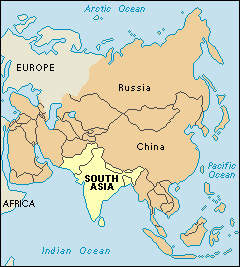
South Asia ranks among the world’s most crowded places. About 2 billion people live there—nearly two-fifths of all Asians and about one-fourth of all the people in the world. The region’s population density of 1,126 persons per square mile (435 per square kilometer) is about 8 times the world average. The Indian cities of Kolkata and Mumbai are two of the most densely populated cities in the world. The population density is even high in many rural regions, particularly in the northern plains of India, South Asia’s chief farming area.
South Asia has much fertile farmland. There are also many large cities, which are thriving and growing fast. In the 1990’s and early 2000’s, many South Asian countries had a surge in economic growth. However, hundreds of millions of people still live in poverty, particularly in the lower Ganges Valley and Bangladesh. 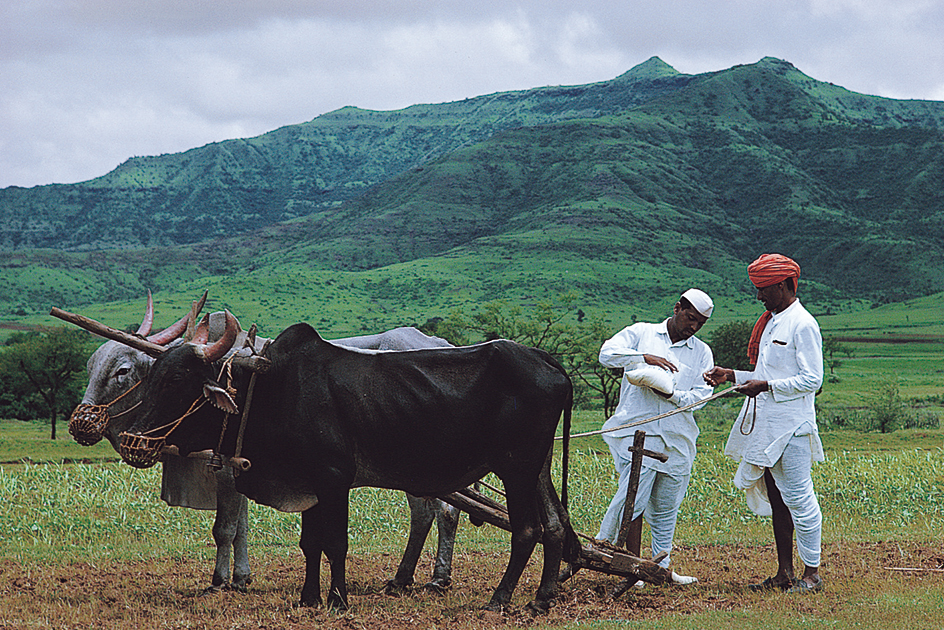
The people.
About 75 percent of South Asia’s people live in India. More than 10 percent live in Pakistan, and a similar percentage also live in Bangladesh.
India’s two largest groups are the Indo-Aryans and the Dravidians. Most of the Indo-Aryans live in northern India. The majority of the Dravidians live in the south. The ancestors of the Indo-Aryans invaded India from Central Asia about 1500 B.C. These people are known as the Aryans. The Aryans conquered the Dravidians in northern India and drove some of them south.
The many groups that make up Pakistan’s population include people of Afghan, Arabic, Aryan, Dravidian, Persian, and Turkish origin. Other South Asian peoples include the Sinhalese of Sri Lanka, whose ancestors came from northern India, and the Maldivians, a people whose ancestors came from southern India, Sri Lanka, eastern Africa, and Arabia. The Tamils of Sri Lanka are descendants of people from southern India. The Nepalese have ancestors who include both Aryans and people from Tibet and Mongolia.
The people of South Asia are divided along the lines of religion, language, and social class. Differences between Hindus and Muslims—the region’s two major religious groups—have often led to conflict and violence. These differences even led to the creation in 1947 of a new nation, Pakistan. In an attempt to end the bloodshed between Hindus and Muslims, the United Kingdom, which then controlled India, divided it into two nations—India for Hindus and Pakistan for Muslims. East Pakistan became the independent nation of Bangladesh in 1971.
Language differences also have far-reaching effects among the people of South Asia. Most states of India, for example, consist chiefly of people who speak the same language. The Indian government changed state boundaries and created new states to give certain language groups their own states. See India (Languages).
In general, social class divides people throughout South Asia. Social standing, however, probably has the greatest importance among the Hindus of India, who make up a majority of South Asia’s population. Each Hindu belongs to a social class called a caste. India has about 3,000 castes. Hindus belong to their parents’ caste and find it hard to join a higher caste. Each caste in India has its own customs. These customs limit both social contact with members of other castes and the extent to which people can move from one class to another through their actions and achievements. Marriage between members of different castes seldom occurs. For more detailed information about the caste system in India, see India (Religion); Caste.
Religions.
About four-fifths of India’s people are Hindus, and more than a tenth are Muslims. Most of the people of Bangladesh, the Maldives, and Pakistan are Muslims. Sri Lanka has a mixture of Buddhists, Christians, Hindus, and Muslims. In Nepal, about 90 percent of the people are Hindus, and most of the others are Buddhists. About two-thirds of Bhutan’s people are Buddhists, and a majority of the rest are Hindus. 
Country life.
About two-thirds of the people of South Asia live in villages and work on nearby farms. The majority of South Asian farmers own a small piece of land, but some rent land from wealthy landlords.
Some farms in South Asia employ modern agricultural tools and methods, but many of the farmers still use the same kinds of tools and farming methods as their ancestors used hundreds of years ago. Large numbers of South Asian farmers must struggle just to raise enough to feed their own families. Most South Asian farm families include not only several children but also the other members of an extended family.
South Asians get most of their food from rice, wheat, millet, barley, and other grains, and from such vegetables as beans and peas. Many Hindus eat no meat. They believe all animals have a soul and must not be killed. See India (Food and drink).
The clothing worn by rural South Asians varies from region to region. Many people wear a large piece of cloth wrapped around the body. Women’s garments of this kind are called saris. Some men cover their heads with a turban. See India (Clothing).
The houses of a typical South Asian village stand close together. Most of them are small and made of sun-dried bricks or mud. A wall surrounds each house in many villages, giving the people a little extra privacy.
There is much contact between rural and urban South Asia. Government officials often go to villages to teach the people how to use modern fertilizers, plows, and seeds. The government also sets up health clinics, schools, roads, and irrigation systems in rural areas.
The struggle to improve the people’s lives faces many difficulties. South Asian governments lack great wealth. But even if they had much wealth, they would be hard-pressed to end poverty quickly. In addition, many rural South Asians are proud of their customs and traditions and feel reluctant to change the way they live and work. However, the economic growth and modernization of urban areas holds promise for the future of the region.
City life.
Although South Asia is chiefly a rural region, it has many large cities. Delhi, Kolkata, and Mumbai in India; Karachi in Pakistan; and Dhaka in Bangladesh rank as the biggest. Many other cities in India and Pakistan also have more than a million people.
Few places present so sharp a contrast between old and new—and between the wealthy and the poor—as do the cities of South Asia. The United Kingdom ruled most of the region from the late 1700’s to the mid-1900’s. During this colonial period, British citizens occupied much of the housing in the sections they had built.
South Asian governments continued to build up the cities after the various nations became independent. Today, middle-class and wealthy South Asians, including business people, doctors, government officials, and lawyers, live primarily in the newest sections.
South Asia’s cities include many slums. Millions of people in these slums live in cheap, crowded apartments and in shacks made of pieces of metal, wood, or cloth. The slums in some cities are so crowded and poverty is so widespread that thousands of people have nowhere to live at all. They sleep in doorways, on sidewalks, or in any other place they can find.
South Asian governments are trying to improve city life as well as rural life. Their efforts include slum clearance and construction programs to provide better housing. However, sometimes these slum clearance programs do not benefit those people living there. The governments also sponsor programs to expand industry and provide more jobs—and to train unskilled workers for those jobs. But the cost of improving any city is high, and the problems are many. High birth rates rank among the major problems. Also, thousands of rural people move to the cities each year in search of a better life. Many end up no better off than they were before.
Education.
More than 90 percent of Sri Lanka’s adults can read and write. However, some countries in the region have low literacy rates. Large numbers of children never go to school at all, either because no school is nearby or because they must work to help support their families.
Since the mid-1900’s, the South Asian governments have built many new schools. More children now attend school than ever before, and literacy rates are improving. But the governments have found it difficult to build enough schools and to train enough teachers to serve their enormous populations.
The arts.
South Asia has a rich and varied artistic tradition. In ancient times, the Aryans produced outstanding literature. Numerous Aryan literary works contributed to the development of Hinduism. Such writings included the epics the Mahabharata and the Ramayana and the philosophical works called the Vedas and the Upanishads. The Aryans composed their works in Sanskrit, the first Indo-European language with a literature. See Sanskrit language; Sanskrit literature. 
Three religions—Buddhism, Islam, and Hinduism—influenced the arts of South Asia. Major Buddhist works include many beautiful sculptures of Buddha, founder of the religion. The Muslims made their major contribution in the field of Islamic architecture. A giant tomb in this style, the magnificent Taj Mahal, is one of the world’s most beautiful buildings (see Taj Mahal). Many Hindu stone temples are richly decorated with sculptures of gods.
Other important arts in South Asia include dance and music. The highly symbolic movements in South Asian dances tell stories and are included in many dramas. South Asian music sounds strange to many Western people because it uses a different scale than does music of the West. South Asian people play much of their music on stringed instruments, such as the lute, sitar, and vina. The flute and the tabla, a type of drum, are also important instruments. 
During the colonial period, the British introduced forms of Western art—including Western architecture and the novel—into South Asia. Today, the art of the region shows the influence of both traditional South Asian art and Western art.
A reversal of the West’s influence on South Asian culture occurred during the mid-1900’s. At that time, South Asian art and philosophy began to attract many people in the West. Sitar music, a physical and mental exercise called yoga, and Hindu religious teachers called gurus became especially popular. The attraction to South Asian culture was most widespread among young people of the West.
Way of life in Southeast Asia
Southeast Asia covers about 1,573,000 square miles (4,074,000 square kilometers), or 9 percent of the continent. The area has an average of 445 persons per square mile (172 per square kilometer)—about three times the world average. The region includes the peninsula east of India and south of China, and thousands of islands south and east of the peninsula.
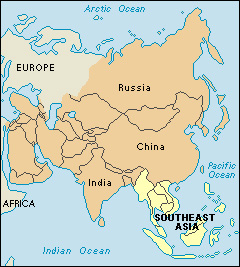
Eleven independent nations make up Southeast Asia. Five of them—Cambodia, Laos, Myanmar, Thailand, and Vietnam—lie on the peninsula. Malaysia lies partly on the peninsula and partly on the island of Borneo. Brunei also lies on Borneo. Indonesia and the Philippines both consist of thousands of islands, and Singapore is made up of one large island and about 50 smaller islands. East Timor takes up about half of Timor Island, the rest of which is part of Indonesia. Geographers consider far eastern Indonesia to be part of Oceania rather than part of Asia.
Southeast Asia has a wealth of natural resources. Forests cover much of the land, valuable minerals lie beneath it, and fish are plentiful in the coastal waters. Much of the soil is fertile, and the rivers and rainfall provide plenty of water. 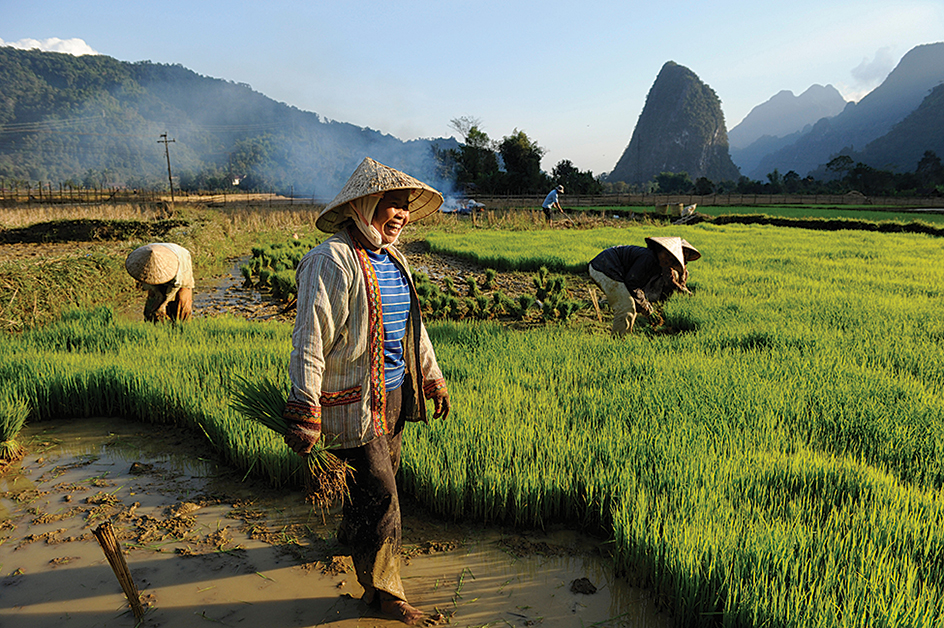
Europeans had established trading outposts in Southeast Asia as early as the 1500’s. In the 1700’s, Europeans began taking control of Southeast Asia. By the late 1800’s, only Thailand remained free of European rule. Many Southeast Asians resented colonialism and fought for independence. These nations began to win independence after World War II ended in 1945.
The people.
About 700 million people, or 15 percent of all Asians, live in Southeast Asia. About half percent live in rural areas, but millions live in large, crowded cities.
The ancestors of most Southeast Asians came to the region from Central Asia and southern China during prehistoric and ancient times. They drove the original inhabitants of the region into the mountains and other remote areas. Today, descendants of the original inhabitants live in those remote areas. Through the years, thousands of people from China and India settled in Southeast Asia. These people control much of the region’s business activity.
Fighting has taken place within and between nations in Southeast Asia, especially as groups there have battled over control of the best land. Through much of the 1900’s, political differences between Communists and non-Communists caused sharp divisions and even fighting among Southeast Asians. The fighting divided the people and stalled economic progress. In 1954, for example, Communists came to power in North Vietnam. A United States-backed government ruled South Vietnam. In 1975—after years of bitter fighting—the Communists took over South Vietnam, Cambodia, and Laos. In 1976, North and South Vietnam united as Vietnam.
Beginning in the 1980’s, relations between Southeast Asian nations—both Communist and non-Communist—markedly improved. By 2000, all of the nations of the region belonged to an economic and political organization known as the Association of Southeast Asian Nations (ASEAN).
Religions.
Buddhism is the chief religion on the peninsula. Islam began in Arabia and spread all the way to Southeast Asia. Today, it ranks as the chief religion in Indonesia, Malaysia, and Brunei. Christianity became the major faith of the Philippines during the period of Spanish rule, and it remains so today.
Many Southeast Asians, especially rural people, mix these religious beliefs and practices with animism, the belief that everything in nature has a spirit. These people believe that good and bad spirits cause good and bad fortune. Some farmers perform traditional religious ceremonies in the hope that the spirits will bring a bountiful harvest. Some of these farmers build small boxes resembling birdhouses on the tops of poles in their rice fields. In the boxes, they put cloth, food, incense, paper, and other offerings to the spirits.
Country life.
The majority of Southeast Asians live in small villages and work on farms. Many Southeast Asian farmers, like farmers elsewhere in Asia, use traditional agricultural methods. They plant by hand and harvest with sickles and other hand tools. Many use water buffaloes to pull large rakelike tools that plow the paddies (rice fields). However, the use of modern farm machines, high-yielding seeds, and chemical fertilizers and pesticides is becoming more common. Rice is the major crop and chief food throughout most of Southeast Asia. 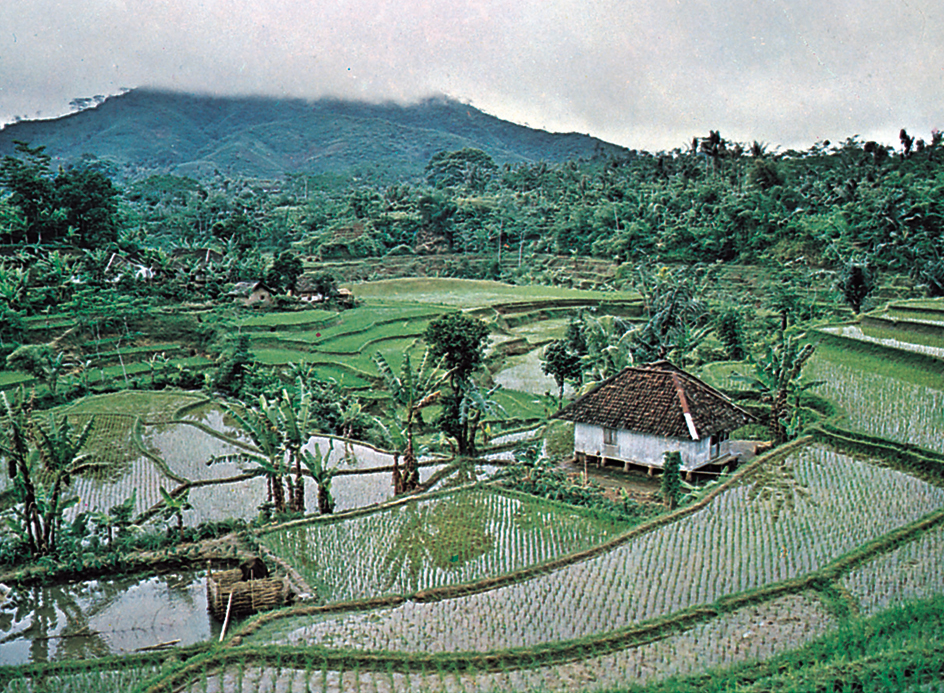
A typical farm village in this region has from 25 to 30 houses, made mostly of bamboo and wood. Many rural Southeast Asians build their houses on raised platforms for protection against insects, wild animals, and heavy rains. The space under the platforms provides shelter for household animals. Almost all villages on the Southeast Asian peninsula include a pagoda or some other Buddhist shrine.
The clothing of Southeast Asia varies widely. Traditionally, farmers wore straw hats to protect them from the sun. Burmese, Indonesians, Malaysians, and Thais wore colorful sarongs (skirts). Although traditional clothing is still popular, many Southeast Asians have adopted clothing similar to that worn by North Americans and Europeans.
Some Southeast Asians, especially islanders, work on large plantations owned by corporations, the government, or wealthy landowners. The plantations produce large quantities of coffee, copra, fruits and vegetables, palm oil, rubber, sugar cane, tea, and tobacco. Most of these products are exported.
Most of the mainland farmers own a small plot of land. Much of the land is fertile and, in good times, almost all the farmers can raise enough food to feed their families. Many have food left over that they sell. Some have begun planting cash crops, such as cashews, cotton, and jute. In general, farmers on the peninsula are better off than those on the islands. Good farmland is scarce on the islands, and a large number of farmers work on land that is owned by others.
Rural Southeast Asians maintain the custom of the extended family. But compared to Southwest Asia and South Asia, relationships between older and younger generations are less rigidly patterned. Social change has led to an increase in nuclear families, which consist only of parents and their children.
City life.
Most of the nations of Southeast Asia have at least one big city, and some nations have several. Jakarta, in Indonesia, and Manila, in the Philippines, are two of the largest cities in the region.
Southeast Asian cities serve as centers of government and manufacturing and as links between the rural areas and the rest of the world. Farm products, lumber, minerals, and other goods go from the rural areas to the cities to be shipped abroad. Goods from other countries pass through the cities before being sent on to the rural areas. Manufacturing takes place in many of the region’s cities. Such large cities as Manila, Jakarta, Bangkok in Thailand, Ho Chi Minh City in Vietnam, and Kuala Lumpur in Malaysia are centers of manufacturing. Singapore is an important financial center. 
Outsiders have long played important roles in Southeast Asian cities. In the 1800’s, Chinese and Indian immigrants began taking over a large part of the retail trade in the cities. Today, in some countries, they are still retail leaders. The European colonial rulers also established businesses and governments in the cities and modernized cities with European-style buildings, services, and facilities.
Southeast Asians continued the modernization process after becoming independent. Many of the cities have luxury hotels, high-rise apartment and office buildings, and other modern features. But like cities everywhere, they include slums and other rundown areas.
Education
varies widely in Southeast Asia, but the region as a whole has a high literacy rate. Since independence, governments have established many new schools and set up special programs to increase literacy. Indonesia, for example, has raised its literacy rate from less than 10 percent in 1945 to about 90 percent today.
The arts.
Precolonial Southeast Asian art reveals much Indian and some Chinese influence. A large part of the art is religious and includes many Hindu and Buddhist monuments. Examples include the Hindu temples at Prambanan and the Buddhist temple Borobudur on the Indonesian island of Java, as well as small Buddhist temple-monasteries called wats in Thailand. Bali has a rich tradition of music, dance, and drama. The art of batik—a decorative method of dyeing cloth—is a distinctive art form of Indonesia and Malaysia. See Indonesia (Arts).
Way of life in East Asia
East Asia covers about 2,556,000 square miles (6,621,000 square kilometers), or 15 percent of the continent. The region includes most of China, the world’s second largest nation in population. Tibet, Qinghai, and Xinjiang, three thinly populated parts of western China, are in Central Asia.
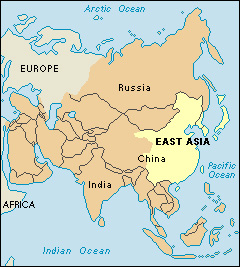
China covers about 90 percent of East Asia, and it has about 85 percent of East Asia’s people. Japan, North Korea, South Korea, and Taiwan are also part of East Asia.
About 13/5 billion people, or about 35 percent of all Asians and 20 percent of all the people in the world, live in East Asia. The region is one of the world’s most crowded places. The population density of East Asia, 628 persons per square mile (243 per square kilometer), is about five times the world average.
Off and on throughout history, China has ruled much of East Asia. The Chinese influence spread through the places they ruled and even to areas they did not rule. Chinese art strongly influenced art throughout East Asia. People throughout the region adopted Chinese religious and philosophical beliefs to some degree.
The Confucian system of ethics is probably the most important Chinese contribution to everyday life in East Asia. This system teaches the duties and manners of rulers and subjects toward each other, of family members toward one another, and of friends toward friends. The Confucian system stresses polite behavior and obedience to proper authority, two lasting characteristics of East Asian society.
The influence of China brought some unity to life in East Asia. But the region has been sharply divided along political lines. China and Japan, East Asia’s two largest nations, have different political systems. A Communist government rules China, and the people have limited political freedom. Japan operates under democratic principles of government, and its people have much freedom.
Political differences divide China and Taiwan and also North Korea and South Korea. The Chinese Communists drove the Chinese Nationalists out of China in 1949. The Nationalists then established their government in Taiwan. Before World War II broke out in 1939, North Korea and South Korea were a single country. Today, Communists rule the north, and non-Communists govern the south. Troops have patrolled both sides of the border between North Korea and South Korea since the two countries fought each other during the Korean War (1950-1953).
The people.
The first East Asian civilization began in China. Today, the Han ethnic group—many of whom are descendants of the early Chinese—make up a majority of China’s people, except in the far north and west. Han people also form a majority in Taiwan. The Koreans are an ancient people who have often come under Chinese rule.
People called the Ainu were among the first inhabitants of some of the islands that now make up Japan. But almost all of the people of Japan today are descended from Asian peoples who settled the country about 2,000 years ago.
Religions.
The Chinese government tolerates religious activity, with some restrictions. Many Chinese still practice the traditional religion of their country. This religion—Buddhism combined with teachings of Confucianism and Taoism—is also the chief faith in Taiwan. Many Koreans practice Buddhism, but their religion also shows Confucian influences. Buddhism and Christianity rank as the leading religions in South Korea. The North Korean government strongly discourages religion. Buddhism and Shinto are Japan’s major faiths, and many Japanese combine the two. Confucianism influences religion in Japan, as it does elsewhere in East Asia.
Life in China.
China has many large cities, including over 150 with a population of 1 million or more. Even so, it has always been an agricultural nation. About half of the people work on farms.
Most Chinese farm families live in two- or three-room houses. These homes are made of mud or clay brick and have a roof of tile or straw. Many city dwellers live in large apartment buildings. However, other city residents live in crowded apartments above stores or behind workshops. Still others live in old neighborhoods where the houses resemble those in rural areas. The Chinese eat mainly rice, wheat, and other grains—often made into such foods as noodles and dumplings—and many vegetables. Fish, pork, and poultry are their main sources of animal protein. 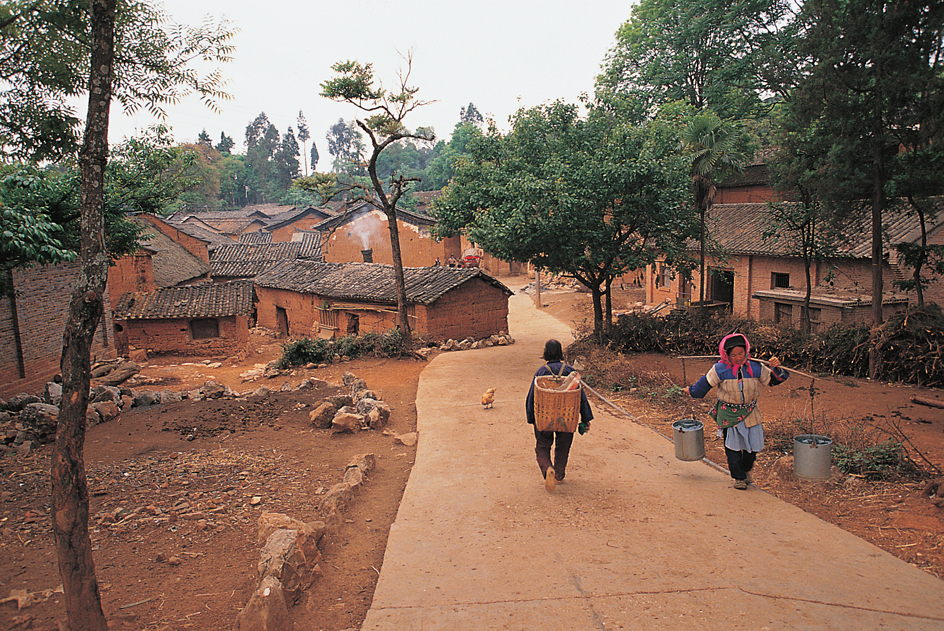
Only about 5 percent of China’s people belong to the Communist Party. However, the party has almost complete control of the country—and it has the power to order sweeping changes in the people’s way of life. In the early 1980’s, for example, the Communists decreed that each married couple should have no more than one child. They hoped to limit China’s population growth by this measure. Other major Communist goals include the elimination of social classes and the modernization of China’s economy. See China (Way of life).
Property.
After the Communists came to power in 1949, they took over most businesses and factories in China. They also collectivized China’s agriculture—that is, they organized the peasants into groups who owned and farmed the land cooperatively. Initially, the farmers were required to give part of their crop to their collective and to sell a quota of farm products to the government at a fixed price. The government has gradually relaxed its requirements. Now many farm families are free to raise and sell crops as they choose and pass the rights to work a specific piece of land on to their descendants. 
The government also encourages families to establish small businesses, such as stores, repair shops, and restaurants. Though the government still owns many large businesses, it has sold many other state-owned enterprises to individuals or companies, and large private corporations have grown rapidly.
Family life
has always been important in Chinese society. In pre-Communist China, extended families were widespread. In such families, the oldest male had authority. Husbands ruled their wives, and parents expected obedience from their children. Today, most family units consist only of parents and children, though some also include grandparents. Relationships within families have become much less rigid, though many of the traditional rules are still followed.
In pre-Communist days, relatively few women worked outside the home. Today, nearly all adults have a job. In many families, a grandparent cares for the children during the day. Many other children stay in day-care centers while their parents work.
Social class.
Confucian teachings gave the Chinese a respect for educated people. In pre-Communist China, a group of scholars who served as government officials ranked just below the emperor and his family in social importance. To become a scholar-official, a person had to learn Confucian philosophy thoroughly and pass difficult civil-service examinations. Other well-educated Chinese, including doctors, lawyers, and teachers, also had high social rank. The Communists, however, teach the principle of egalitarianism. According to this principle, all people, no matter what their occupation, have equal social rank. In practice, though, some groups of people—such as government officials—have much more power, wealth, and prestige than others.
The economy.
China has some areas of good farmland, and it ranks among the leading producers of many crops. But China has such a large population that it must struggle to raise enough food for everyone.
The Chinese government has made great strides in reducing poverty through the modernization of the country’s agriculture and industry. Chinese agricultural production has increased, but most farmers still use traditional tools and farming methods.
China’s economy began to grow rapidly in the 1980’s. Since then, China has greatly increased industrial production, and the country’s standard of living has improved rapidly. But further growth will depend on China’s acquiring new technology and training highly skilled workers and technicians. 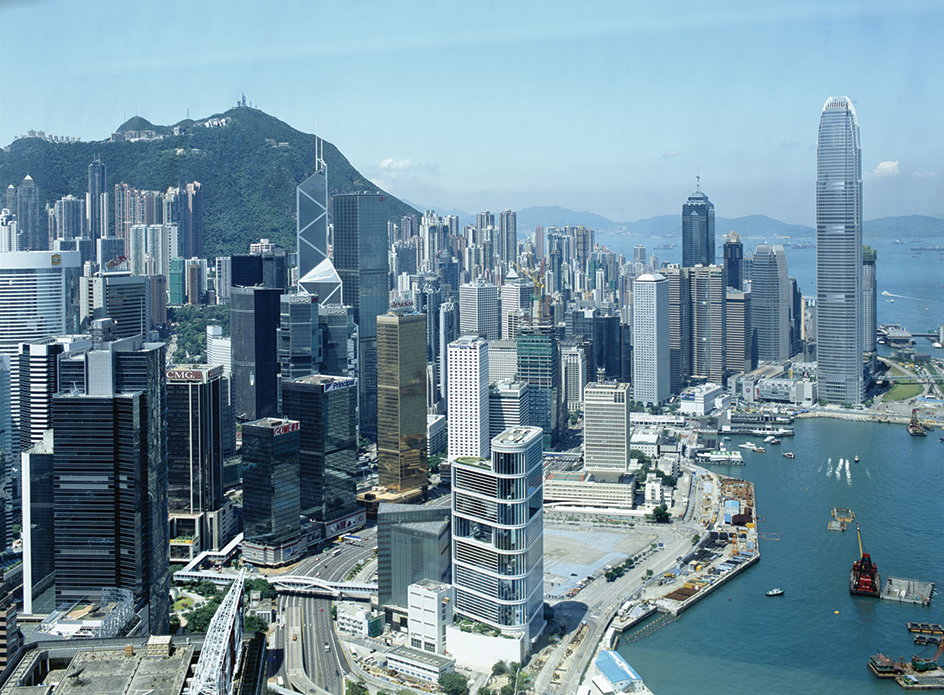
Life in Japan
differs greatly from that in most of the rest of Asia. About 90 percent of its people live in urban areas. Japan’s cities are busy, modern centers of commerce and industry. Tokyo, the capital of Japan, is one of the world’s largest cities. Tokyo is also the chief city in the heavily populated Tokyo-Yokohama urban area.
Japan ranks among the world’s main industrial nations. Manufacturing has made the country an industrial giant. The Japanese have one of the world’s highest standards of living. Most Japanese are employed in the industrial and service sectors. But Japan also has many small family farms, which the government protects with laws and subsidies (payments). 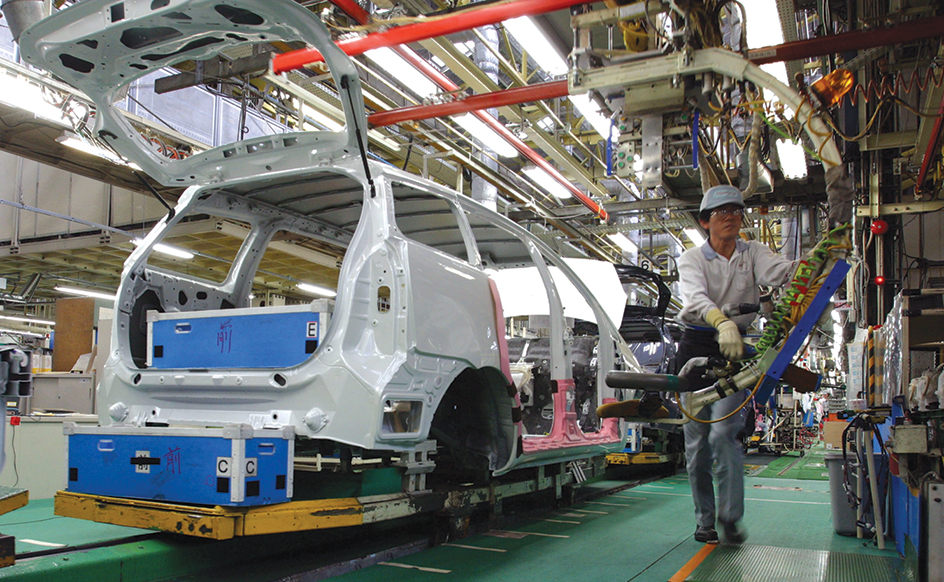
Japan’s farms also reflect a modern way of life. Almost all Japanese farmers own their own land. The use of chemical fertilizers, farm machinery, and other advanced agricultural methods is more common in Japan than anywhere else in Asia. But most farms are small, and the government must provide financial assistance for many farms. Even so, many Japanese farmers have to seek part-time work outside the farm.
The Japanese, more than many other Asian peoples, have adopted features of Western life, especially American life. For example, baseball ranks as Japan’s favorite sport, and neon signs light up many city streets. Some Japanese, especially older people, wear the traditional kimono (loose robe) at home and for special occasions. But most people in Japan wear clothing similar to that worn by North Americans and Europeans. 
The Japanese have also kept many old traditions, including their deep respect for beauty. Shinto, once Japan’s state religion, teaches love of nature’s beauty. Zen, a branch of Buddhism chiefly practiced in Japan, is famous for its emphasis on beauty in even simple things. Long ago, monks in Zen monasteries made art forms of everyday functions, including bathing, flower arranging, gardening, and tea drinking. These and other artistic traditions became—and remain—part of the way of life for people in Japan.
Many people in Japan, including the wealthy, live in a traditional plain, wooden Japanese house. Most of these homes have a garden and a high surrounding wall. Almost every Japanese family that can afford it owns at least one brush painting mounted on a scroll. At many meals, the Japanese serve each food in a separate bowl to emphasize the food’s color, shape, and texture. Rice remains the chief food.
The extended family is not nearly so common in Japan as it was before the 1900’s. But the Japanese still have strong family ties and a deep respect for authority. They expect individuals to obey all people who have authority over them, including their father and older brothers, and government officials. At the same time, persons in authority must act courteously toward others. This rule comes from an old belief that one person should never embarrass another.
Economic growth and modernization began in Japan in the mid-1800’s. Before that time, Japan’s rulers worked to keep the country free from outside influences. Japan ended its isolation when it began trading with the United States during the 1850’s. It adopted Western economic ways and made itself a world power while maintaining its social and cultural distinctiveness.
Japan’s economic progress suffered a major setback with the nation’s defeat in World War II. But the Japanese, with help from the United States and its allies, rebuilt their country and its economy with astonishing speed.
Korea and Taiwan.
North Korea modeled its economic, political, and social systems on those of other Communist countries. Rural people, who make up about a third of the population, live on collective farms operated by the government. Most of the country’s industrial workers live in city apartments and work in factories owned and operated by the government.
Agriculture is still important in South Korea and Taiwan, but both countries have rapidly developed into industrial states since the 1950’s. Their economies expanded, and living standards rose greatly. 
Education.
Japan, Taiwan, and North and South Korea have high literacy rates. Almost all people 15 years of age or older in those countries can read and write. All Japanese attend elementary school and high school, and a high percentage go on to college.
In China, the government has expanded elementary education. During the 1940’s, only a small percentage of the people could read and write. Today, about 95 percent of all Chinese 15 years of age or older can do so. The country is also expanding higher education.
The arts.
East Asia has one of the world’s oldest and richest artistic traditions. The Chinese created artworks before the beginning of written history. Through the years, Chinese artists became masters in many art forms, including architecture, painted porcelain, carving, scroll painting, and sculpture. Much Chinese art shows Buddhist or other religious subject matter. Chinese artists also portrayed people, animals, and nature, and created beautiful designs and rich colors. Chinese art has influenced artists throughout East Asia.
In China today, artists strive for self-expression. But the government discourages art that is critical of Communism. Both Japan and South Korea have continued their rich artistic traditions but have also adopted some Western art forms. For example, the people of both countries enjoy Western plays, television dramas, and motion pictures. Filmmakers in Japan and China, especially Hong Kong, produce hundreds of movies yearly, many of which have won international awards.
For more detailed information on East Asian art, see the Arts section of the articles on China and Japan. See also the articles on specific art forms, including Architecture; Painting; and Sculpture.
Way of life in North Asia
North Asia covers about 5 million square miles (12,800,000 square kilometers), or about 30 percent of the continent. It is the largest region in Asia, extending from the Ural Mountains to the Pacific Ocean. North Asia consists entirely of Siberia, which makes up about 75 percent of Russia. The rest of Russia lies west of the Urals, in Europe.
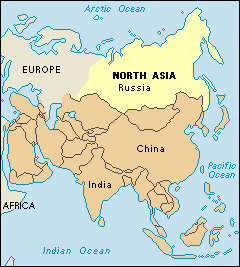
North Asia covers more land than any other region in Asia but has the smallest population. About 32 million people live in the region, or about 1 percent of Asia’s total. North Asia has a population density of only 6 1/2 persons per square mile (2.5 per square kilometer).
A harsh climate has limited North Asia’s development and population growth. The region has an abundance of natural resources, including many minerals, vast oil fields, rich forests, and grasslands in the extreme southwest that are good for farming. But the winters are long and bitter. Ice and snow cover most of the region about six months of the year. The temperature can drop below –90 °F (–68 °C). Most of the coastal waters, lakes, and rivers freeze for much of the year.
Because of North Asia’s isolation, imperial Russia and the Soviet Union used it as a place of exile and imprisonment. The Soviet Union was a Communist country that covered nearly two-fifths of Asia from 1922 until the country broke apart in 1991. Russia was the most important republic in the Soviet Union. Soviet rulers sent millions of criminal and political prisoners to isolated parts of Siberia. Many prisoners were forced to work building factories, mines, and railroads. The large-scale use of forced labor for Siberian construction projects ended soon after the death of Soviet dictator Joseph Stalin in 1953.
The people.
Most Siberians are Russians. Ethnic Russians are descended from Slavs who lived in Eastern Europe several thousand years ago. Such Mongol and Turkic groups as Buryats, Tuvinians, and Yakuts lived in Siberia originally, and descendants of these peoples still live there.
Religion.
Russian Orthodoxy, a branch of Christianity, is the chief religion among North Asians of European descent. Many descendants of the original North Asians practice Buddhism or Islam.
Life of the people.
Many North Asians farm, fish, or work in factories or mines. Most North Asian factories operate in cities along the Trans-Siberian Railroad.

About 70 percent of Siberia’s people live in cities. Most city people are crowded into small apartments. Many people in rural areas live in simple, but more spacious, log houses. Novosibirsk is the largest city in Siberia. It has a population of about 11/2 million.
Education.
Almost all Russians can read and write. Public education is free for all citizens. Children attend school for 11 years, from ages 6 to 17.
The arts.
Much art of North Asia shows Chinese and Islamic influence. Some art shows Christian influence.
Way of life in Central Asia
Central Asia covers about 3,489,000 square miles (9,035,000 square kilometers), or about 20 percent of the continent. It is the second largest region in Asia. Only North Asia has more land. Central Asia includes Tibet, Qinghai, and Xinjiang, which lie in western China, and the independent nations of Kazakhstan, Kyrgyzstan, Mongolia, Tajikistan, Turkmenistan, and Uzbekistan. Qinghai is a province of China. China calls Tibet and Xinjiang autonomous (self-governing) regions, but the Chinese government actually rules them. A tiny part of Kazakhstan lies west of the Ural River, on the continent of Europe.
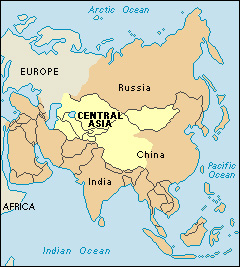
Except Mongolia and the Chinese-controlled areas, the lands of Central Asia were once part of the Communist-led Soviet Union, which broke up in 1991. These nations have moved away from the Communist system to other forms of government. However, most have retained close ties to Russia.
Central Asia is a region of high plateaus and mountains, vast deserts, and treeless, grassy plains. Much of the land is too dry or too rugged for farming. Many people earn a living by herding livestock. Industrial activity centers in the region’s few cities. 
About 125 million people live in Central Asia, or about 3 percent of the continent’s population. Of the regions of Asia, only North Asia has fewer people. Central Asia has a population density of 36 persons per square mile (124 per square kilometer).
The people.
The people of Mongolia are called Mongols. The great conqueror Genghis Khan united various Mongol tribes in the early 1200’s. He and his grandson Kublai Khan built the largest land empire in history. It extended from China and Korea, across much of Central and Southwest Asia, and into Europe. The people of Central Asia’s other independent nations include the Kazakhs, the Kyrgyz ethnic group, and ethnic Tajiks, Turkmen, and Uzbeks.
Even though Qinghai, Tibet, and Xinjiang are part of China, most of their people are not Han Chinese. Tibetans make up the population of Tibet and much of the population of Qinghai. Tibetans have lived in the area since ancient times. Uyghurs (also spelled Uighurs), a people of Turkic origin, make up about half of Xinjiang’s population. Tibet and Xinjiang are also home to increasing numbers of Han Chinese, who have moved there from other regions of China.
Religion.
Most Central Asians are Muslims. Islam is the chief religion in Kazakhstan, Kyrgyzstan, Tajikistan, Turkmenistan, and Uzbekistan. When these areas were part of the Soviet Union, the Communist government discouraged religion, but people continued to practice their faith. These nations now allow religious freedom.
Islam is also the chief religion in the Chinese region of Xinjiang. Lamaism, a branch of Buddhism, is the chief religion in Mongolia, Tibet, and Qinghai. The Chinese Communists tolerate religion but attempt to maintain control over religious groups. The Communists recognize several religions but restrict the practice of others. The Chinese government has at times persecuted religious believers.
Life of the people.
All of Central Asia was once under Communist control. Today, only Qinghai, Tibet, and Xinjiang continue to be ruled by a Communist government. The six independent nations of Central Asia have moved to other forms of government, and they have removed controls that existed in such areas as religion, education, and the arts.
Tashkent, the capital of Uzbekistan, is the largest city in Central Asia. It has about 2 million people. Most city dwellers live in single-story houses or apartment buildings. The majority of the people of Central Asia live in rural areas. Most of them farm or raise livestock.
In much of Central Asia, people in rural areas live in mud-brick houses in villages. Many rural villages do not have electric power or running water. Most families are large, and many members of an extended family may live together in one household. Such a household might include parents, married children and their offspring, and other relatives. Some rural people live in traditional tentlike dwellings called yurts. These portable homes are constructed of a circular wooden frame covered with felt.
Many of Mongolia’s people live on livestock farms. The farms are like huge ranches with small towns in the center. The central buildings include houses, offices, shops, and medical centers.
In Xinjiang, large numbers of people are herders who live near oases. Many people farm on the oases.
The Chinese Communists seized Tibet in 1950. Before that time, few parts of the world were so completely controlled by religious leaders as was Tibet. Buddhist monks ruled the country and owned most of the land. The monks and a small group of nobles made up Tibet’s upper class. Farmers and wandering herders formed Tibet’s lower class. The farmers worked the land, and most nomads tended the flocks of monks and nobles.
The Chinese government reduced the power and wealth of the monks and nobles. They broke up many large estates and took over the land or distributed it among the people. They also reduced the importance of religion. The work of farmers and herders has changed little since the Chinese take-over. But the farmers and herders give much of what they produce to the government rather than to landowners.
Education.
Most of the people in Central Asia can read and write. Most children attend school for 11 years, from ages 6 to 17. Teaching Communist principles is an important part of the curriculum in Qinghai, Tibet, and Xinjiang.
The arts.
Carpet making is an important craft in Central Asia. Other important crafts include embroidery and jewelry making. In Kazakhstan and Kyrgyzstan, the recitation of epics (poems about heroic events) is an important part of the culture. In the Chinese regions of Central Asia, the arts, like education, formerly centered around religion but today are intended to serve Communism. However, the Chinese have relaxed many controls on artistic expression.
The land
Asia, the world’s largest continent, covers about 17 million square miles (44 million square kilometers), or about 30 percent of the world’s land area. It extends from the Arabian Peninsula, Turkey, and the Ural Mountains eastward to the Pacific Ocean. From the Arctic Ocean, it reaches south to the Indian Ocean. Geographers consider thousands of islands off the mainland as part of Asia. These islands include—roughly from west to east—Cyprus, the Maldives, Sri Lanka, most of Indonesia, the Philippines, Taiwan, and Japan. 
Asia and Europe are part of the same mass of land. No body of water separates the two completely, and so some geographers consider them as a single continent called Eurasia. Certain physical features mark the division between Asia and Europe. The Ural Mountains, Ural River, and Caspian Sea act as a northern boundary between east and west. The Dardanelles, Sea of Marmara, Bosporus Straight, Black Sea, and Caucasus Mountains link to form a border between north and south in the west.
Asia has some of the world’s highest mountains, largest deserts and plains, most important rivers, and best—and worst—soil. This section describes each land region of Asia. It also tells about Asia’s major natural features and how they affect the lives of the people.
Land regions.
Asia has six major land regions, as discussed in the Way of life sections of this article. Southwest Asia is a land of desert in the south and of mountains and plateaus in the north. Dry soil makes farming difficult in most of the region. But Southwest Asia’s land contains much oil, one of the world’s most valuable natural resources. The northern border of South Asia includes the Himalaya, the world’s highest mountain range. Much fertile soil lies south of the mountains. Southeast Asia is rich in natural resources, including fertile soil, forests, and mineral deposits. East Asia also has much fertile soil and other valuable resources.
Forests cover a large part of North Asia, and areas of good farmland lie in the southwestern section of this region. But much of northern North Asia is so cold that the land stays frozen throughout most of the year. Central Asia has much of the continent’s poorest land. Its main features include deserts, mountains, and rocky plateaus.
Mountains.
Asia has more mountains than any other continent. The mountains make transportation difficult in many places. They also separate people from each other and have hindered the exchange of ideas. Over the centuries, some mountain areas, such as in Lebanon, have attracted minority groups seeking shelter from persecution. Melting ice and snow from mountaintops feed many Asian rivers. Millions of farmers depend on water from these rivers to grow crops.
Many of the major Asian mountain systems branch out from a large group of rugged peaks and deep valleys called the Pamirs. This area lies where Afghanistan, China, and Tajikistan meet. It is sometimes called the roof of the world. Some peaks in the Pamirs tower more than 25,000 feet (7,620 meters) above sea level. The floors of some of the valleys are as much as 4 miles (6 kilometers) below the peaks.
The Tian Shan range extends northeast from the Pamirs into Xinjiang. The Altai Mountains form part of the boundary between Mongolia and Xinjiang. Beyond these high ranges, the smaller mountains of such ranges as the Stanovoy and Yablonovyy reach across southern Siberia toward the Sea of Okhotsk.
The Kunlun Mountains extend east from the Pamirs. This range forms the Qilian Mountains in eastern Tibet, then becomes the Qinling range in central China.
The Karakoram Range extends southeast from the Pamirs. The famous Himalaya rises south of the Karakoram Range and extends along Tibet’s southern border. The lofty Himalaya includes many of the world’s highest peaks. On the border between Nepal and Tibet, Mount Everest—the world’s highest mountain—rises 29,032 feet (8,849 meters) above sea level. 
The Hindu Kush range extends west from the Pamirs across Afghanistan. Farther west, the Elburz, Zagros, and other ranges enclose the high Plateau of Iran. The Pontic and Taurus mountains surround Turkey’s Plateau of Anatolia near the western end of Asia. The Caucasus Mountains extend through southern Russia, Georgia, and Azerbaijan. The Caucasus Mountains form one of the boundary lines between Asia and Europe.
Rivers.
Millions of Asians live crowded together in the continent’s river valleys and deltas. The rivers play an important role in the lives of the people. Many rivers aid farmers by depositing fertile soil along their courses and providing water for irrigation. They also serve as important transportation routes for trade and travel.
Southwest Asia’s major rivers flow through the northern part of the region. The Tigris and Euphrates rivers begin in Turkey and meet in Iraq, forming the Shatt al Arab. The Karun River flows from Iran into the Shatt al Arab, which empties into the Persian Gulf. The Jordan River flows south from Lebanon into the Dead Sea. 
In South Asia, several rivers flow south from the mountains in the northern part of the region. The main ones include the Indus, which winds through Pakistan and into the Arabian Sea; and the Brahmaputra and Ganges, which flow through northern India and Bangladesh before emptying into the Bay of Bengal. The delta, a low plain formed from sediments, at the mouth of the Brahmaputra and Ganges is the largest river delta in the world.
Four important Southeast Asian rivers begin in the mountains that are in and near Tibet. There, the Irrawaddy, Mekong, Menam (Chao Phraya), and Salween rivers start their long routes through Southeast Asia to the sea.
East Asia’s major rivers, the Huang He (Yellow River) and Yangtze River (also called Chang Jiang), begin in the Tibetan Highlands and flow east across China. The Huang He empties into the Yellow Sea, and the Yangtze empties into the East China Sea. The Yangtze, which measures 3,900 miles (6,275 kilometers) long, is Asia’s longest river. The Xi Jiang (West River), southern China’s chief river, flows from south-central China into the South China Sea.
The major rivers of North Asia—the Lena, Ob, and Yenisey—flow from south to north through northern Siberia. They empty into the Arctic Ocean. The Amur River is the major waterway of far eastern Siberia.
Large parts of Central Asia have no rivers. But important rivers rise in the mountains of that region.
Deserts and plains.
Deserts extend diagonally across Asia from the Arabian Peninsula northeast to China and Mongolia. These huge deserts are unsuitable for farming, and few people live there.
The Arabian Desert makes up most of the Arabian Peninsula. Other deserts cover much of the rest of Southwest Asia. A desert called Karakum occupies most of Turkmenistan. Kyzylkum is a desert that spreads across southern Kazakhstan and northern Uzbekistan. The Thar Desert stretches across much of the border between India and Pakistan. Farther east, the Taklimakan of western China and the Gobi of China and Mongolia form huge wastelands. The frozen tundra region that is in northern Russia is sometimes called a cold desert because so few plants can grow there (see Tundra).
Plains are flatlands. Rivers cut through most plains and rain falls on them, helping make the soil fertile. The major Asian plains include those that lie across northern India, eastern China, northern Kazakhstan, and central Russia.
Coastline, bays, seas, and lakes.
Asia’s coastline measures about 80,205 miles (129,077 kilometers)—over three times the distance around Earth’s equator. Many harbors along the coast are shallow. Through the years, mud and silt carried downstream by rivers have partly filled the harbors. Asia’s northern harbors, on the Arctic Ocean, stay frozen much of the year.
Two huge bays of the Indian Ocean indent Asia’s southern coast. These are the Bay of Bengal east of India, and the Arabian Sea west of India.
Along Asia’s east coast, islands and peninsulas block off parts of the Pacific Ocean into a series of seas. These seas include—from north to south—the Bering, Okhotsk, Japan, Yellow, East China, and South China seas.
The Red Sea lies between the continents of Asia and Africa. The Aegean, Black, and Caspian seas make up part of the boundary between Asia and Europe. The Caspian Sea, which lies north of Iran, is the world’s largest inland body of water. It is not really a sea but a salt lake that covers 143,250 square miles (371,000 square kilometers).
Other lakes include Lake Baikal in Russia; Lake Balkhash in Kazakhstan; the Aral Sea, which lies between Kazakhstan and Uzbekistan; and the Dead Sea, between Israel and Jordan. The Dead Sea shore, about 1,411 feet (430 meters) below sea level, is the lowest place on Earth.
Climate
Because of Asia’s tremendous size, its regions have a wide variety of climates. These varied climates include the bitter cold of the polar north; the hot, dry desert environment of Central Asia and Southwest Asia; and the hot, humid conditions of the tropical south.
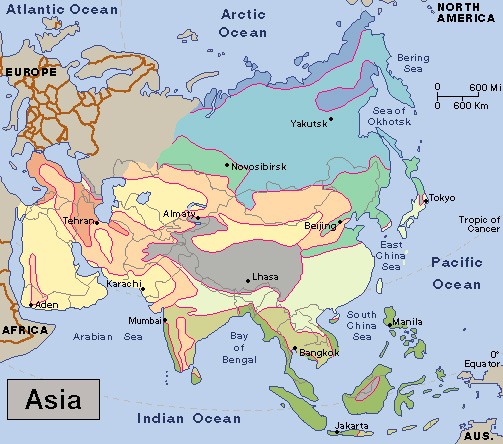
Winds called monsoons influence the climate of much of Asia. A monsoon blows regularly in the same direction during definite seasons. In winter, monsoons from the north move into East Asia and cause cold, dry weather. The wind switches in summer and blows from the seas that lie south and southeast of that region. It causes hot, humid weather.
Most of East Asia’s rain falls between April and October. The rainfall is heaviest in the east, and it decreases away from the sea.
Monsoons pass through South Asia and Southeast Asia from November to March. They cause the coolest weather in those two regions. Beginning in April, monsoons from the southwest send temperatures soaring. From May to October, wet monsoons bring heavy rains from the south seas. Many of these monsoons cause floods.
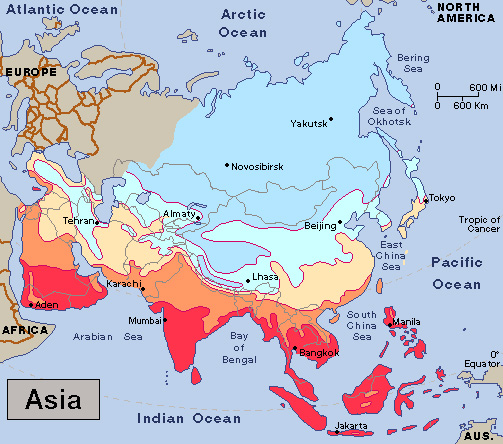
In Southwest Asia, monsoons affect only the southern and southwestern coasts of the Arabian Peninsula. Most of Southwest Asia has long, hot summers and mild winters. Inland, temperatures often climb above 115 °F (46 °C) in summer. But there are no clouds to keep the daytime heat close to Earth at night. A warm but comfortable night may follow an extremely hot day. The region’s heaviest rains fall in Turkey near the Black Sea and in the Caucasus region between the Black and Caspian seas. Some parts of the Arabian Peninsula receive no rain for several years at a time.
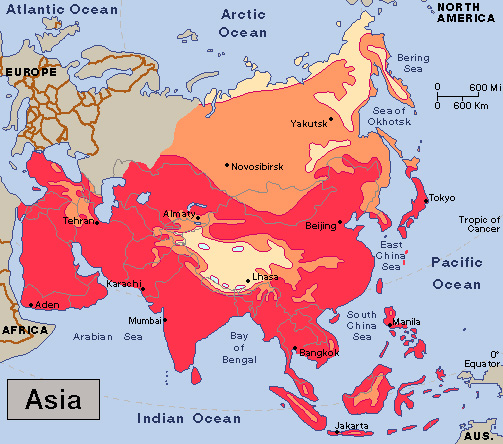
Bitter cold polar weather keeps part of northern Siberia’s land frozen the year around. In the grasslands in the southwest, the temperatures vary from 3 °F (–16 °C) in January to 64 °F (18 °C) in July. Central Asia’s climate ranges from extremely cold in its mountain regions to hot and dry in the deserts in the summer.
Animals
Domesticated animals.
Many Asian people use domesticated (tamed) animals to do work and as sources of food, clothing, and shelter. Useful domesticated animals include the dromedary and other camels of Southwest Asia, and the elephant and the ox or bullock of South Asia. Other domesticated animals used by Asian people are the yak and Bactrian camel of Central Asia, the water buffalo of Southeast and East Asia, and the reindeer of North Asia.
Wild animals.
Arctic foxes, Arctic hares, lemmings, and reindeer live in the Arctic. Lemmings live under the snow in the winter. Many animals in North Asia south of the Arctic are highly valued for their fur. They include brown bears, elks, ermines, lynxes, martens, otters, and sables.
Antelopes, burrowing rodents, and locusts live in Mongolia and northwestern China. From time to time, swarms of locusts attack the fields of northern China, eating the crops in their paths. The giant panda, a black-and-white bear, lives in the wild only in China.
China’s industrial boom has created significant pollution that threatens some of its wildlife. For example, water pollution, heavy river traffic, and dam building have caused the Yangtze river dolphin to become critically endangered and possibly extinct.
South and Southeast Asia have the continent’s greatest variety of wild animals. Apes and monkeys and beautiful tropical birds are plentiful in these regions. Some animals—including elephants, crocodiles, leopards, rhinoceroses, scorpions, tigers, and poisonous snakes—can endanger the rural people. Wild animals of Southwest Asia include antelopes, caracals, onagers, and ibexes and other wild goats. The region’s deserts support many insects and reptiles.
Plants
Few kinds of plants can survive in the Arctic area of North Asia. But the world’s largest fir and pine forest lies south of the Arctic. Its trees supply lumber, pulpwood, and other products.
The dry land of most of Central Asia supports little plant life except for grasses. But grass serves as the food for livestock, the basis of Central Asia’s economy.
Valuable plant life grows in eastern East Asia, which has plentiful rain. Trees supply East Asians with fruit, lumber, and paper. The people use the leaves of the mulberry tree to feed silkworms, which produce silk thread for clothing.
Much valuable plant life also grows in the warm, wet climate of Southeast Asia and parts of South Asia. Products from plants account for a large part of the exports of these regions. People in many parts of the world use products from the nutmeg, rubber, and teak trees, the tea bush, and bamboo grass.
Few plants grow in the dry parts of Southwest Asia. But date palms and olive trees of desert oases provide many people with a large amount of the food they eat and export.
Agriculture
Agriculture is still the most important economic activity in Asia in terms of people’s livelihoods. About half of the people make a living from farming. Farm products also account for a large part of Asia’s exports.
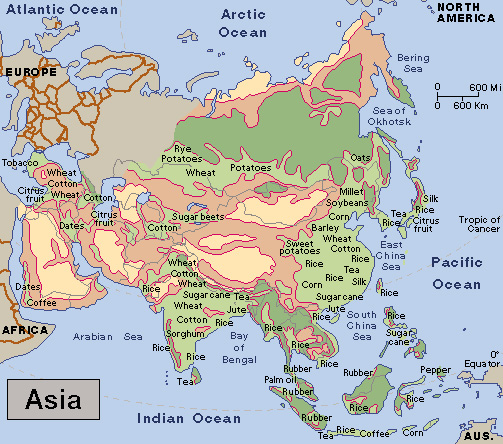
In many Asian countries, most of the farmers use hand tools, and many have animals that pull plows and do other work. Countries such as China and Bangladesh produce high crop yields, largely through intensive hand labor and the use of every bit of available land. Even so, these nations have so many people that there is barely enough food to go around.
The use of modern farm tools and chemical fertilizers has become widespread in some Asian nations, including Israel, Japan, and the countries that were formerly part of the Soviet Union. Some Asian nations have increased farm productivity by the use of irrigation and new, higher-yielding rice and wheat seeds. These countries include China, India, South Korea, and Thailand.
This section gives an overview of how farms are organized in Asia and of Asia’s major crops and livestock animals. The six Way of life sections of this article provide more information on how rural Asians live and work.
Farm organization
in Asia follows three chief systems: private ownership, tenant farming, and collective farming.
Some farmers in all parts of Asia own their own farms. Private farm ownership is most common, however, in South Asia and on the mainland of Southeast Asia. Many farmers in these areas own a small plot of land.
Tenant farming is also practiced in many parts of the continent but is probably most common in Southwest Asia. Many farmers in that region work on land they rent from wealthy landlords. They pay the landlords with crops or money.
Few collective farms still exist. Israel has many collective farming communities called kibbutzim, and there are still some collective farms in China.
The Communist countries of Asia formerly practiced collective farming, but it proved inefficient and unpopular. The Chinese government introduced collective farming communities called communes in 1958 but began abandoning them in 1979. The government then tried a system similar to tenant farming. Farm families produced a certain amount of crops for the state. They could sell whatever excess they produced on the open market. The Chinese government gradually relaxed its crop requirements. Now many farm families raise and sell crops as they choose.
Crops.
South Asia, Southeast Asia, East Asia, and southwestern North Asia rank as the continent’s main crop-growing regions. The land and climate of most of Southwest Asia, Central Asia, and North Asia are poorly suited to farming.
The chief crops of Asia are rice and wheat. The countries of Asia—led by China and India—produce more than 90 percent of the world’s supply of rice, and Thailand is the world’s largest rice exporter. Asia’s leading wheat-producing countries include China, India, Russia, and Turkey.
Most of the world’s natural rubber and tea come from Asia. Indonesia, Malaysia, and Thailand are the top natural-rubber producers in the world. Asia’s leading tea-growing countries include India, China, Sri Lanka, and Indonesia. 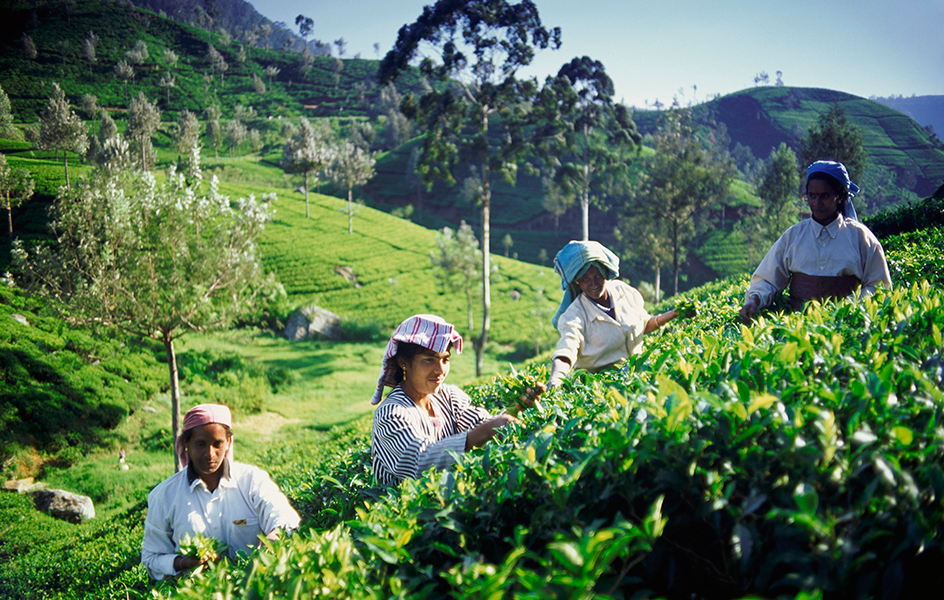
Other important Asian crops include cotton, jute (fiber from which burlap is made), and sugar cane. China, India, Pakistan, Turkey, Turkmenistan, and Uzbekistan stand among the leading cotton-growing nations. Jute comes chiefly from Bangladesh, China, and India. India ranks second in the world in the production of sugar cane. Only Brazil produces more.
The opium poppy is grown in parts of Asia, including Afghanistan and Myanmar. Such powerful drugs as heroin, morphine, and opium are made from this flower. Doctors prescribe such drugs to ease pain. However, millions of people around the world abuse the drugs, often becoming addicted to them. See Drug misuse (Misuse of illegal drugs).
Livestock.
In South Asia, Hindu farmers who raise cattle use the animals to obtain milk and ghee (a clarified, liquid form of butter) and for work. Because cows are sacred to Hindus, the farmers do not slaughter the animals at the end of their working lives. India has the largest population of cattle of any nation. In the less fertile parts of Central, North, and Southwest Asia, many people raise livestock for a living. They get cheese, milk, and meat from their animals, as well as fur and hides for clothing and shelter. Manure from livestock is used as fertilizer and sometimes as a cooking fuel.
Some of the animals are used for transportation. Livestock farmers also sell animals or products made from them to buy supplies.
Hogs and poultry are raised for food throughout most of East Asia and Southeast Asia. Camels, goats, and sheep are the most important livestock in Southwest Asia. Central Asians herd Bactrian camels, cattle, goats, horses, pigs, sheep, and yaks. Reindeer herding is a major activity in the northern part of North Asia.
Industry
Industry is growing rapidly in many East, South, and Southeast Asian nations. These countries have prospered as their industries have expanded. Japan, China, and India rank among the largest economies in the world. But most other Asian nations have relatively little manufacturing and depend heavily on agriculture.
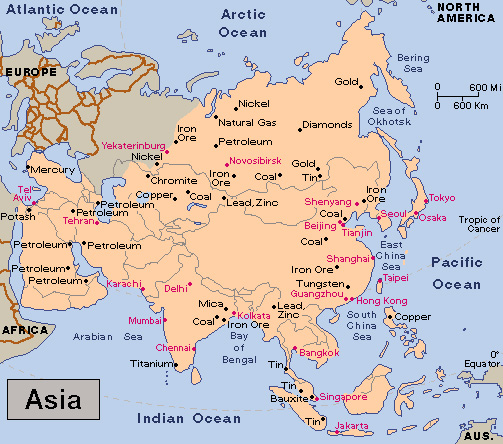
Mining.
Raw mined materials rank among Asia’s most important exports. Southwest Asia supplies a large part of the world’s oil. Southeast Asia provides much of the world’s tin. China’s exports include antimony, barite, fluorite, graphite, granite, and tungsten. India’s exports include bauxite, iron ore, and zinc. Chromite mined in Turkey and the Philippines is exported to many parts of the world.
Asia used to export most of its raw mined materials to industrialized nations on other continents. But because of rapid economic growth, Asia is becoming a major importer of raw materials from other regions.
Manufacturing.
During colonial days, Asia served as a source of food for Europe’s people and as a source of raw materials for its industries. The processing of food and other products became important in Asia, and it still is today. Such industries as sugar refining and the processing of fish, rice, and tobacco have major economic importance in some parts of the continent.
Most of Asia’s heavy manufacturing takes place in such countries as China, India, Japan, Russia, South Korea, and Taiwan, all of which have large, modern factories. Industries in these countries make such products as automobiles, electronic equipment, factory machinery, iron and steel, military weapons, and ships. Israel, North Korea, Singapore, and Turkey also have some heavy industry. 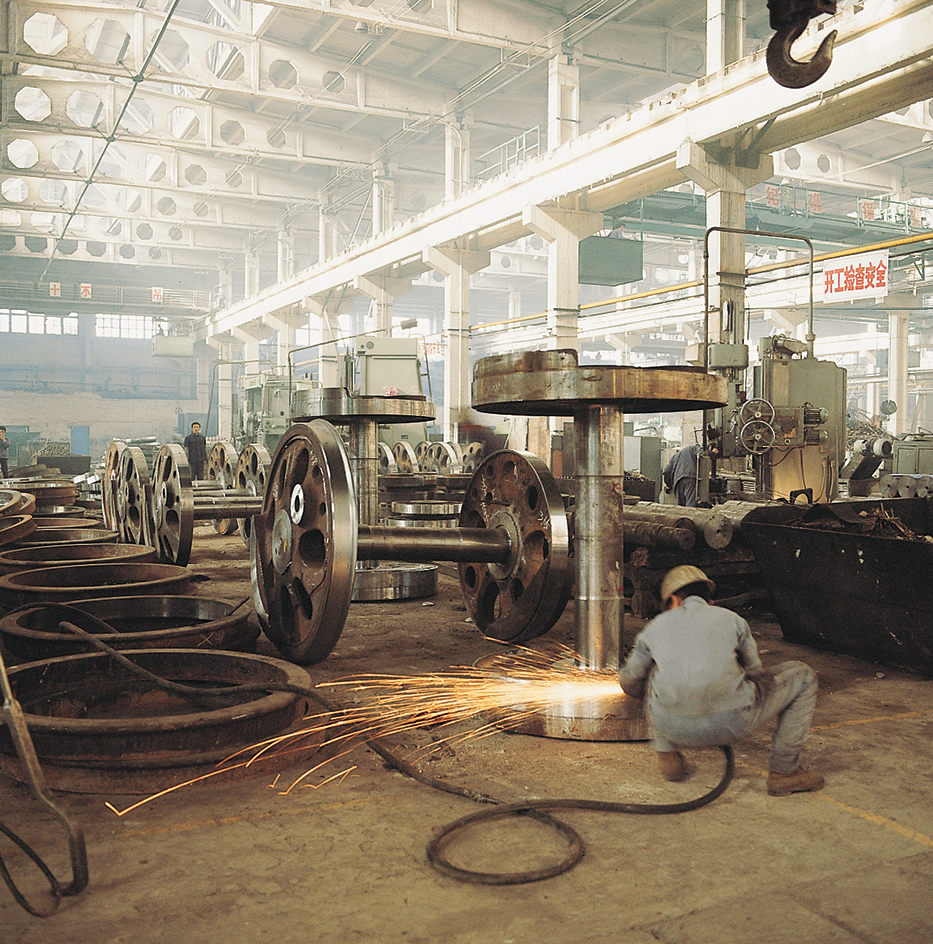
Other industries.
Light industries play an important role in the economies of such countries as Indonesia, Malaysia, and Thailand. Many Southeast Asian countries manufacture textiles, footwear, personal electronic products, and other consumer goods, primarily for export.
Millions of Asians who live along the seacoasts and rivers catch fish for a living. The countries of China, India, Indonesia, Japan, Russia, and Thailand rank among the most important fishing nations of the world.
Tourism and a related industry, handicrafts, have great economic importance in many parts of Asia. Large numbers of non-Asians visit the continent each year, and many Asians travel outside their home countries within Asia. The tourists spend money on food, transportation, lodging, and such handicrafts as carvings, leather goods, metalware, pottery, rugs, and textiles. The tourist industry is especially active in South, Southeast, and East Asia. 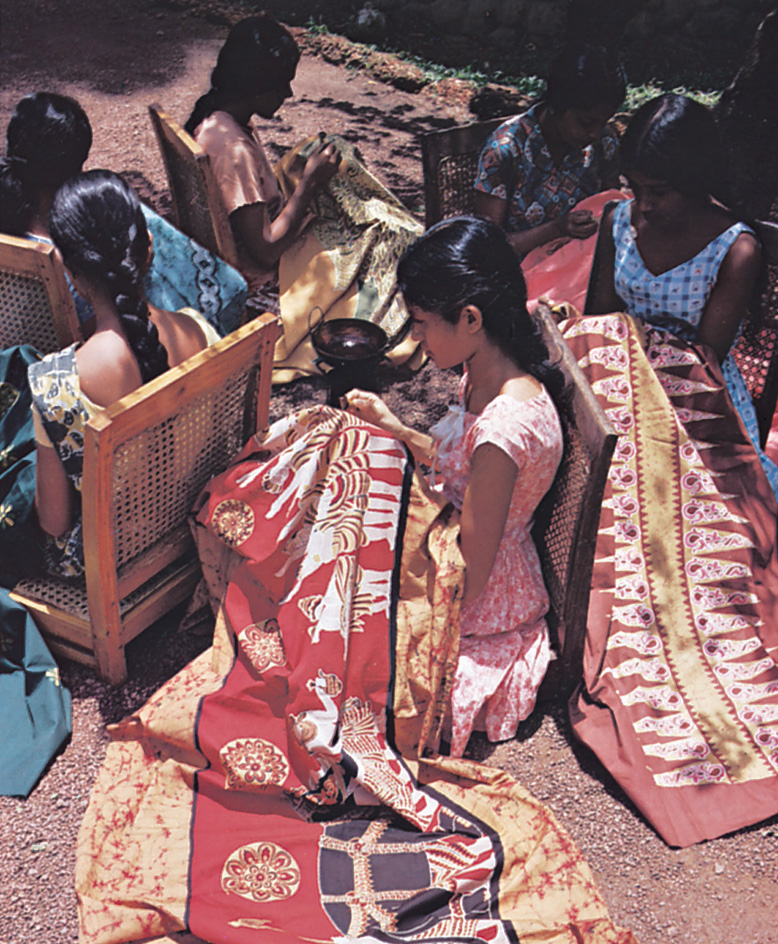
Industrial development.
Many Asian governments are trying to improve the economies of their nations by creating new industries and by expanding old ones. Some countries offer low tax rates to non-Asian business people to set up businesses in Asia. Asian governments have also used their own funds and aid from other countries to establish industries. The governments sold some of these industries to Asian business people at low cost. Many changes in Asian education have been aimed at training people in industrial skills.
A number of Asian countries have succeeded in increasing their industry. Japan is one of the world’s leading industrial nations. It exports cars, electronics, and other consumer goods throughout the world. China and India have huge factories and manufacture a wide variety of goods. Israel, South Korea, and Taiwan have also made great progress in industrial development. Such other Asian nations as Malaysia, Pakistan, the Philippines, Thailand, and Turkey are developing modern industry. Since the late 1900’s, the governments of Asia’s Communist countries have begun to loosen government controls and to encourage private enterprise and foreign investment. 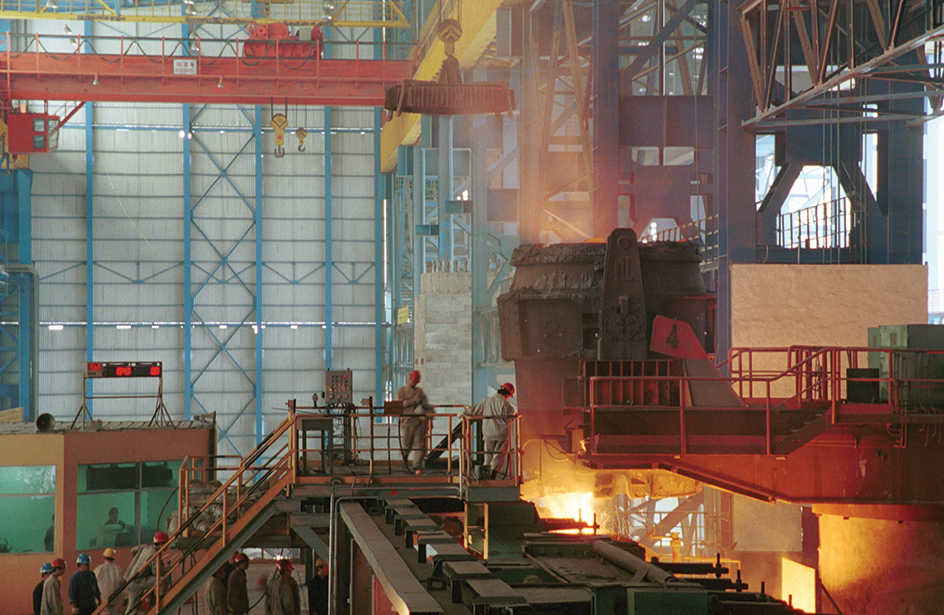
Most other Asian countries have little industry other than the processing of agricultural products and raw materials. Saudi Arabia and other oil-producing nations have large oil refineries. The Asian countries that were once part of the Soviet Union face the need to replace old industrial equipment and develop new markets for their goods.
Transportation and communication
The transportation and communication systems of Asia’s cities are more advanced than those of the rural areas. The cities have many of the same modern devices that Western cities have. But in some rural areas, transportation and communication differ little from what they were hundreds of years ago.
Transportation.
Many kinds of vehicles transport people and goods in Asian cities. Automobiles, buses, motor scooters, and trucks speed by vehicles powered by people or animals. People supply the power for such vehicles as bicycles and pedicabs. The pedicab, a taxicab operated like a bicycle, has largely replaced the jinrikisha and other taxis pulled by runners (see Jinrikisha; Pedicab). Oxen, water buffaloes, and other animals pull carts through the streets of some cities. Many cities have mass transit systems.
Motor vehicles are less common in rural Asia. Buses travel along the rural roads, many of which are unpaved. Some people share the ownership of a jeep. Many villagers transport goods in carts pulled by animals or people. Others travel by foot—to save wear and tear on their animals. Carts get stuck in the soft sands of the deserts, and so many people use the sure-footed camel for desert transportation.
Rivers rank among the chief transportation routes of rural Asia. The people use barges, canoelike vessels, junks, sampans, and other small boats for travel and to transport goods. Junks and some other boats of rural Asia have sails and are moved by the wind. But many Asians must paddle their boats or move them by pushing a long pole against the river bottom. Sometimes, people on shore pull heavy barges by means of long ropes attached to the barges. People in Iraq sail an unusual boat called a kufa that looks like a huge bowl.
Airlines link most large Asian cities with one another and with other parts of the world. But railroads are still the continent’s chief means of long-distance transportation. Colonial rulers built a large network of railroads during the late 1800’s. They used trains to carry raw materials from inland areas to coastal cities and ports. Today, almost all Asian countries have at least one railroad. More trains are needed, however, to handle increased passenger and cargo loads. Asia also has a shortage of railroad managers, train repair personnel, and replacement parts for old trains. Japan has one of the world’s most modern railroad systems. 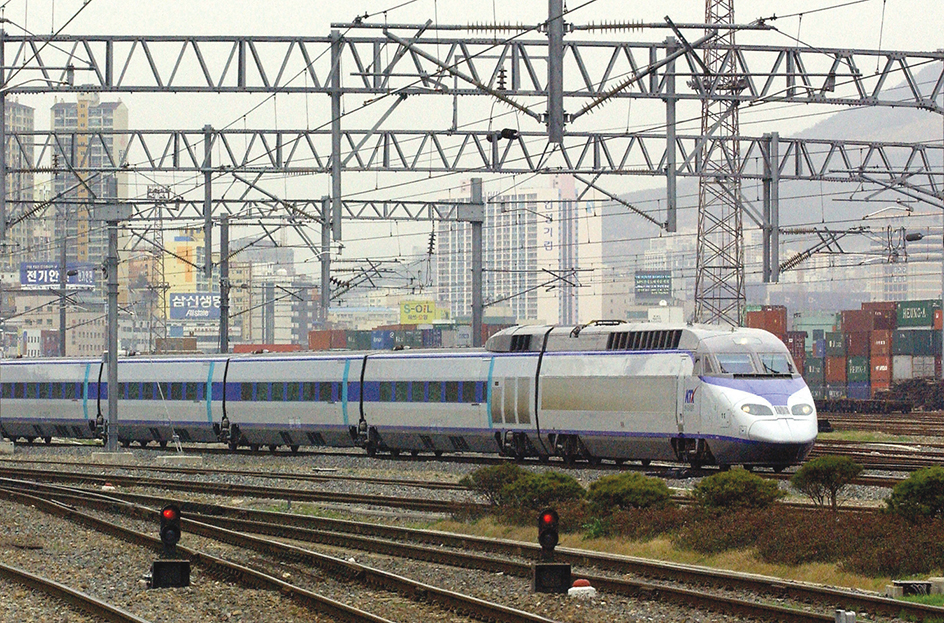
The colonial rulers also built up Asia’s highway system between inland areas and coastal cities. Since the end of colonial rule, Asian nations have continued to build or improve highways so that more trucks and buses can use them.
Oceangoing vessels carry much cargo to and from Asia’s ports. These huge modern ships tower above the small, old-fashioned sampans and other boats that dockworkers use while loading and unloading them.
Communication
in some Asian countries is much the same as in Western countries. Many people read newspapers. Radio and television stations broadcast from most cities. Most households have radios, many households own television sets, and most of the population has internet access.
In other Asian countries, newspapers, radio stations, and television stations are less numerous. Broadcasts do not reach some rural areas. Some families own radios, but few own television sets, and only a small portion of the population has access to the internet. Satellite television receivers and mobile telephones enable some rural communities to stay in touch with the rest of the world.
History
Four areas of the world are sometimes called the cradles of civilization because of the important early civilizations that began there. One of these areas is in Egypt and the other three are in Asia. The Asian cradles of civilization are (1) the Tigris-Euphrates Valley, now mostly Iraq, in Southwest Asia; (2) the Indus Valley of South Asia; and (3) the Huang He and Yangtze valleys of China, in East Asia.

The Tigris-Euphrates Valley,
near the head of the Persian Gulf, was the site of the world’s first civilization, in the area known as Mesopotamia. This valley forms the center of a larger historic region called the Fertile Crescent. This region, named for its rich farmland, follows the Tigris and Euphrates rivers north and west from the Persian Gulf. Then it curves south through the valley of the Jordan River. The region includes parts of what are now Iraq, Israel, Jordan, Lebanon, and Syria.
Ruins of old cities dot the Fertile Crescent. Archaeologists have discovered much about the ancient civilizations that existed in the area between about 3500 B.C. and the 200’s B.C. These civilizations included the Sumerian, Babylonian, and Assyrian civilizations.
The Sumerians developed the world’s first civilization about 3500 B.C. They invented a method of writing, called cuneiform, and used it to inscribe clay tablets. The Sumerians traded widely with other peoples, including the Egyptians. Sumerian armies had war chariots a thousand years before the Egyptians did. The Sumerians also developed a complicated system of laws governing weights, measures, and trading.
No one really knows why Sumer declined. But by about 1900 B.C., the first of several great Babylonian dynasties appeared in the region north of Sumer. Babylon became the capital city of an advanced civilization that gained fame for its laws, religion, and walled cities.
The Assyrian Empire, north of Babylonia, began to expand after 883 B.C. For about 100 years, between 728 and 626 B.C., Assyria controlled Babylonia. Babylonia regained its independence after King Ashurbanipal of Assyria died in 627 B.C. But the Persians conquered the empire in 539 B.C. 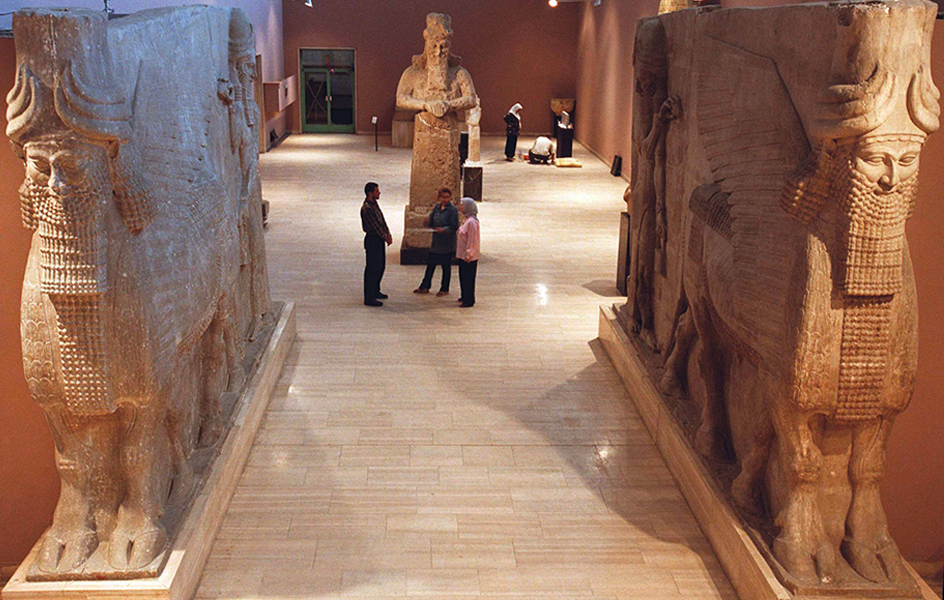
The Persian Empire reached its height about 520 B.C. At that time, it included much of Southwest Asia and parts of South Asia, the southern part of Russia, and North Africa. Persia’s importance lasted nearly 200 years. Alexander the Great conquered the Persian Empire in 331 B.C. (see Alexander the Great).
The Indus Valley.
From about 2600 B.C. to about 1900 B.C., an advanced Bronze Age culture developed in South Asia. This civilization spread through the valley of the Indus River and included hundreds of settlements in what are now Pakistan and northwestern India. Scholars do not know how the Indus society began, nor if its people were related to the peoples of Southwest Asia.
About 1500 B.C., nomadic tribes called Aryans invaded India. The Aryans probably came from the plains north of the Caspian Sea. They gradually spread their culture eastward to the Ganges Valley. The Aryans developed the religious and social practices that formed the basis of later Hindu cultures. By 517 B.C., the Persian Empire had started to overrun the Indus Valley.
From 327 to 325 B.C., Alexander the Great conquered the Indus area. But he soon gave up his rule over the area, and India came under the control of Buddhist rulers. Buddhist dynasties controlled much of the Indian subcontinent for hundreds of years. The greatest empire in this period was that of Ashoka. He united nearly two-thirds of South Asia during his rule, which lasted from about 272 to 232 B.C. Art and literature thrived during Ashoka’s reign.
The Huang He and Yangtze valleys
of north and central China make up the third early center of Asian culture. In the Huang He Valley, during the 1700’s B.C., the Shang dynasty became the first major civilization of East Asia. Palaces filled the Shang capital of Anyang. Shang priests used pictograms (simple drawings representing words) to report events and keep records. This early picture writing formed the basis of the written Chinese language.
The Zhou (also spelled Chou) dynasty replaced Shang rule about 1045 B.C. The Zhou dynasty was centered in the Yangtze Valley. During Zhou rule, Chinese art and learning flourished. Great thinkers, such as Confucius and Laozi (also spelled Lao Tzu), laid the basis of East Asian philosophy. Internal wars weakened the Zhou dynasty after 403 B.C., and the dynasty ended in 256 B.C. Several large states controlled China until 221 B.C., when the Qin (also spelled Ch’in) dynasty took over. 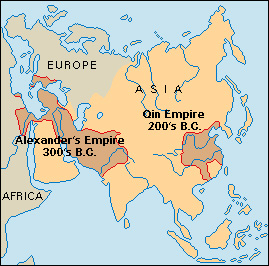
Qin rulers created the first united Chinese empire. The first Qin ruler, Shi Huangdi, ordered major construction on the Great Wall of China in an attempt to protect the empire from the nomadic peoples of the north. But rebel warriors overthrew the Qin rulers in the late 200’s B.C. China’s next dynasty, the Han, ruled a large empire from 202 B.C. to A.D. 220.
Nomadic invasions
destroyed ancient civilizations in all parts of Asia after A.D. 300. For centuries, nomads poured out of Central Asia and southern North Asia. In East Asia, during the 300’s, the Huns of Mongolia conquered northern China. Then they turned west and invaded Europe, where they contributed to the fall of the Roman Empire. In about 500, Huns ended India’s 180-year-old Gupta Empire. 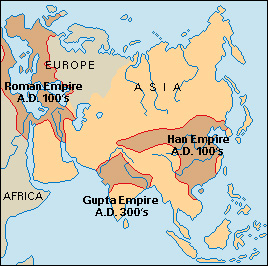
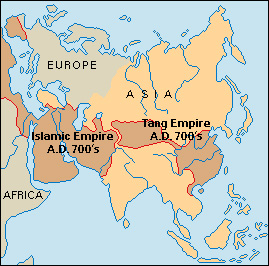

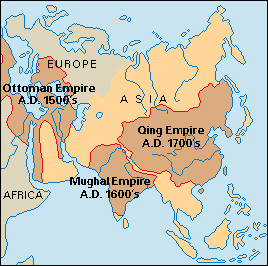
From the early 600’s to the 1100’s, when nomadic invasions and religious wars weakened western Asia, East Asia had peace. The Tang and Song (also spelled Sung) dynasties ruled China during that period. They developed gunpowder, printing, paper money, and porcelain.
Muslim peoples conquered Southwest Asia during the 600’s and built an empire that included North Africa and most of Spain and Portugal. From the 300’s to the 1100’s, the Byzantine Empire in the eastern Mediterranean area was the only Christian power in Asia. That Christian influence eroded as the empire fell to the Ottomans, Muslim nomadic Turkish tribes that had migrated to the Middle East from Central Asia. Over several centuries, the Ottomans steadily occupied Byzantine territories and established the expansive Ottoman Empire. In 1453, they captured the Byzantine capital, Constantinople, which then became known as Istanbul.
New invasions came from the center of Asia after 1206, when Genghis Khan united Mongol tribes and conquered northern China, northern India, Persia (now Iran), and parts of Europe. The Mongol Empire extended from China and Korea to the Danube River in Europe. It was the largest land empire in history. The empire lasted until 1368, but it achieved its greatest importance during the mid-1200’s under Kublai Khan.
After the fall of the Mongol Empire, the Ming dynasty gained control of China and spread its power throughout most of East Asia. During the nearly 300 years of Ming rule, Chinese art and literature flourished.
In 1526, Mongols again invaded India and established the Mughal Empire. About the same time, the Ottoman Empire reached its height in Southwest Asia. Ottoman rule also extended to North Africa and southeastern Europe. But none of these empires remained powerful. Europeans had entered a period of cultural and economic expansion that resulted in their conquest of Asia.
The Western conquest of Asia
began during the early 1500’s. The desire for Asia’s riches—especially control of the spice trade—excited Europe, and an age of colonial expansion followed. In the 1500’s, the Portuguese took control of Indian Ocean trade routes and obtained Macau and Melaka as ports for trade. The Spanish began trading in the Philippines about 1565. The English and Dutch entered the Asian trade after 1600. The Dutch gained a foothold in Java in 1619. They took Melaka from the Portuguese in 1641 to control the spice trade.
In Japan, the strong Tokugawa rulers forced the Spanish and Portuguese to leave the country in 1639. Japan allowed only the Dutch to send a ship to trade at Nagasaki once a year. China, under the Qing dynasty of the Manchus, also closed its doors to the West. Foreign traders were permitted only at Guangzhou (Canton).
The British and Dutch, stopped from trading with China and Japan, turned to South and Southeast Asia. The British gradually conquered most of India, and the Dutch took over the East Indies (now Indonesia). At about the same time, European Russians pushed into Siberia from the west.
The age of colonialism.
Europe and the United States brought their economic and military strength to bear on Asia during the 1800’s. In 1839, China and the United Kingdom began the First Anglo-Chinese War (also called the First Opium War), a battle over opening China to imports. China lost and, in 1842, agreed to British trade at five Chinese ports. Two years later, China began trading with the United States and France. In 1854, Matthew C. Perry, the leader of an American naval mission, signed a treaty that opened Japan to limited U.S. trade.
A period of fierce competition began among Western powers seeking Asian trade and colonial expansion. The United Kingdom became a powerful force in Southwest Asia, India, Southeast Asia, and southern China. Russia expanded into Central Asia and Manchuria. The French colonized Indochina (the area that is now Cambodia, Laos, and Vietnam). The United States acquired the Philippines from Spain in 1898, after the Spanish-American War.
By the 1900’s, Western influence had produced great changes throughout Asia. Western art influenced Asian art, and the colonials built large parts of Asian cities in a Western style. The colonials played the leading part in the economic and political life of much of Asia. However, many people in rural areas remained unaffected by Western influence.
During World War I (1914-1918), the United Kingdom, France, and other Allied nations occupied the Ottoman Empire, which collapsed during the war. After the war, several of the new countries created from the empire were placed under the administration of the United Kingdom or France. This system, called the mandate system, lasted until the 1940’s. 
The colonials made great profits through their control of Asia. At the same time, large numbers of Asians lived in poverty and had no voice in their government. Many Asians were dissatisfied with colonialism and demanded that Asians rule Asia. New feelings of nationalism grew up in many parts of the continent. In time, these nationalist movements ended colonialism in Asia.
The rise of the Japanese Empire.
Japan overthrew the Tokugawa system of government in 1867. After adopting a constitutional monarchy in 1889, Japan quickly rose to great power in eastern Asia. From 1894 to 1905, in wars with China and Russia, Japan won the island of Taiwan and a foothold in Manchuria and Korea.
A new republic replaced China’s Qin dynasty in 1912, but China found it difficult to build a strong new government. For many years, warlords fought for control of the country. Finally, in 1928, the Chinese Nationalists united China under one government. But the Nationalists still had to contend with rival Communist groups, which left the nation open to attack. 
In 1931, Japanese troops invaded Manchuria. Six years later, they swept into central China. The troops left China only partly conquered and began to drive toward Southeast Asia and the Pacific Islands.
In 1941, Japan joined Germany and Italy in World War II. At the height of its power, in 1942, the Japanese Empire extended from the Aleutian Islands of Alaska, south to the Netherlands Indies, and as far west as Burma (now Myanmar). The huge empire collapsed with Japan’s defeat in 1945. See World War II (The war in Asia and the Pacific).
The end of colonialism.
The Allied victory in World War II returned most of the colonies to the Western powers, but only for a short time. Feelings of nationalism in Asia had grown during the war. Mohandas K. Gandhi, who led India’s movement for independence from the United Kingdom, was perhaps the most famous Asian nationalist. 
Between 1943 and 1949, Burma, Ceylon (now called Sri Lanka), India, Indonesia, Pakistan, and the Philippines changed from colonies into nations. A number of Southwest Asian colonies and territories also became independent nations. In addition, a new nation, Israel, was formed in 1948 as a homeland for Jews. In 1949, Indochina was the only part of Asia that still had major Western colonies. However, that region gained independence five years later.
Results of colonialism.
With the end of colonialism, most Asian nations again controlled their own development. But years of colonial rule had left Asia poorly prepared in some ways to face the modern world.
Economically, Asia lagged far behind the West. An industrial boom in the West, which began during the 1700’s, provided jobs for the rapidly increasing population. The boom enriched governments and business people and gradually raised the living standard of most of the population. The West also made major improvements in farm tools and methods. 
Under colonial rule, Asia provided raw materials needed for Western industry. But most of Asia did not become industrialized. Nor did the continent experience much agricultural improvement. As a result, poverty became more widespread in Asia than in the West.
Colonialism also slowed Asia’s political and military development. At the same time Western nations ruled Asia, they developed a tradition of strong central government that their colonial possessions lacked. After the Europeans left, various groups in many Asian nations struggled for political power. In many cases, Asians who came to power had difficulty establishing their authority over all the people in their countries. Political factions divided many nations.
Western nations developed militarily during the colonial period. But in Asia, the colonial rulers—not the Asians—were responsible for the military defense of the lands they governed. After the colonial rulers left, many Asian nations found themselves without suitable military protection. This military weakness added to Asia’s problems.
Colonial rule also left a deep impact on Asian culture. Many Asians adopted Western dress, architecture, education, and ideas, often blending their traditions with Western ways. In many countries, colonial rulers created an elite Westernized class. The elite took power after colonial rule ended.
The spread of Communism.
Two Asian nations—the Soviet Union and Mongolia—turned Communist in the 1920’s, long before World War II. By the time the war began in 1939, Communist parties had gained strength in many other parts of the continent. The Communists spoke out against colonial rule and used their stand against colonialism to gain followers. During World War II, many Communists fought alongside the Allies, some of which were colonial powers. But after the war, the Communists called for an end to colonialism and sought power for themselves.
In 1949, the Chinese Communists defeated the Chinese Nationalists. Mao Zedong led the Communists during most of their 22-year struggle for control of China. With this victory, Communists controlled Asia’s two largest nations—China and the Soviet Union.
At the end of World War II, Korean Communists took control of North Korea, and non-Communist Koreans took over South Korea. In 1950, the North Koreans invaded South Korea, touching off the first international war between Communists and non-Communists. The United States and other non-Communist nations fought on the side of the South Koreans. North Korea’s allies included China, which sent troops, and the Soviet Union, which sent supplies. The Korean War ended in 1953. But Korea still remains divided between a Communist north and a non-Communist south. 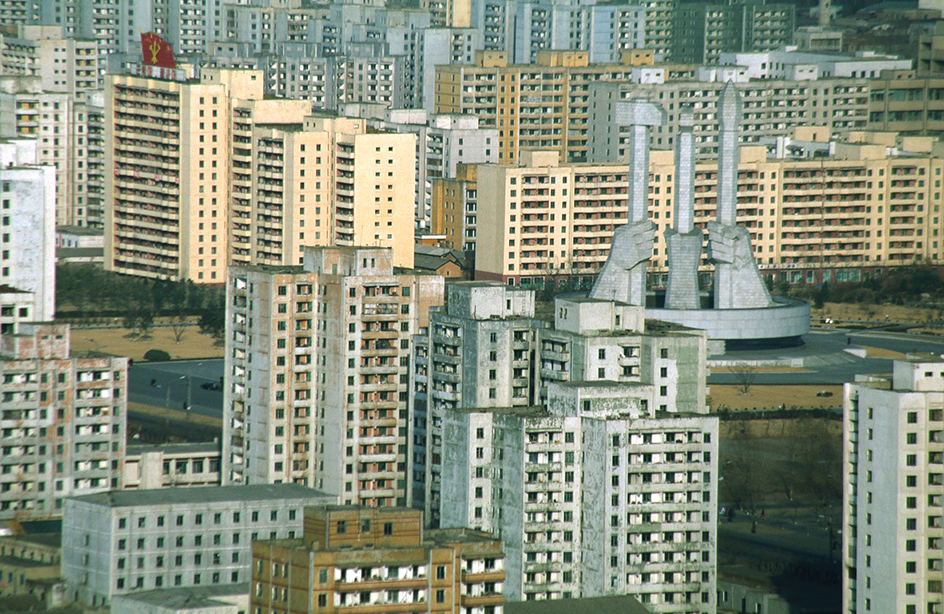
Communism also gained a foothold in Southeast Asia. In 1946, Communists in Vietnam, which was then a colony of French Indochina, began a long war against the French forces there. A nationalist group called the Vietminh, headed by the Communist leader Ho Chi Minh, led the movement. The Communists finally defeated the French in 1954. Indochina was then divided into four independent nations—Cambodia, Laos, North Vietnam, and South Vietnam.
The fighting did not end when the French left. Communists in Cambodia, Laos, and South Vietnam continued to fight the new non-Communist governments. North Vietnam sent troops and supplies to help them, and China and the Soviet Union sent supplies. The United States sent supplies to the non-Communist countries.
In the early 1960’s, South Vietnam seemed about to fall to the Communists. The United States sent troops to help defend South Vietnam. A cease-fire agreement ended U.S. participation in the fighting in 1973. But clashes continued between the Vietnamese Communists and non-Communists. Battles also flared up in Cambodia and Laos during the 1960’s and early 1970’s. In 1975, Communists took control of South Vietnam, Cambodia, and Laos. North and South Vietnam were reunited in 1976. Communist rebels have fought against the governments of several other Asian countries, including Myanmar, the Philippines, and Thailand. See Vietnam War.
The decline of Communism.
In 1978, leftist military leaders gained control of the government of Afghanistan. Many Afghans rebelled against the new government. At the end of 1979, the Soviet Union began sending troops to help the Afghan government crush the rebels, called mujahideen. Muslims from Saudi Arabia and other Arab countries supported the rebels in their fight against Soviet control. The Afghanistan government and its Soviet allies could not defeat the rebels. The Soviet Union withdrew its troops in 1988 and 1989. The war between the rebels and the government in Afghanistan continued until 1992, when the rebels overthrew the government.
Also in 1979, Vietnamese troops crossed into neighboring Cambodia and overthrew the Communist Khmer Rouge regime. The Khmer Rouge had seized control of Cambodia in 1975 and enforced its rule by torture and terror. Members of the Khmer Rouge retreated into the jungles of northern Cambodia and carried out attacks on the new Vietnam-backed government. The Khmer Rouge movement gradually weakened before coming to an end in the late 1990’s.
Communism went into retreat across much of Asia beginning in the 1980’s. Mongolia changed from a Communist system of government to a democratic one in 1990. By the end of 1991, the Soviet Union had ceased to exist as a country. First, Communist rule ended there after conservative Communist officials failed in an attempt to overthrow Soviet leader Mikhail S. Gorbachev. After the failed attempt, most of the Soviet republics declared their independence. In December 1991, Gorbachev resigned, and the Soviet Union was dissolved. Russia and the other former Soviet republics became independent nations.
By 1992, Communists held a monopoly on power in only a few Asian countries, including China, Laos, North Korea, and Vietnam. But the governments of China, Laos, and Vietnam were introducing economic reforms.
Arab-Israeli conflicts.
Israel and the Arabs of Southwest Asia and North Africa have struggled since Israel was founded in 1948. Many Arabs have claimed that the Israelis have no right to a Jewish state in the historic region of Palestine (now Israel, the West Bank, and the Gaza Strip). The Arab people known as the Palestinians lived in the region long before Jews began moving there in large numbers in the late 1800’s.
Since 1948, the Arabs and the Israelis have fought four major wars. In a 1967 war, Israel gained control of the West Bank and the Gaza Strip. Starting in 1994, Israel withdrew from some areas in the West Bank and Gaza, and Palestinian officials took control of them. In 1996, Palestinians in these areas elected a legislature and president for a government called the Palestinian Authority (PA).
Violence between Israelis and Palestinians increased briefly in 2006, 2008, 2009, and 2012. Fighting between Palestinian groups also increased. In 2006, Hamas, a radical Palestinian organization and political party, won PA elections. In 2007, Hamas seized control of the Gaza Strip by force. Palestinian President Mahmoud Abbas of the Fatah party dismissed the Hamas-led government and declared a state of emergency. Hamas continued to control the Gaza Strip, and Fatah controlled the PA in the West Bank. In June 2014, after many years of negotiations, a combined Fatah and Hamas Palestinian government was formed.
Other struggles.
Fighting in Asia has not been limited to the struggle between Communists and non-Communists and between Arabs and Israelis. Ethnic friction, power struggles within nations, border disputes, and other causes have led to fighting among many Asian peoples.
Chinese forces took control of neighboring Tibet in 1950. Since then, native Tibetans have sought independence a number of times but have been unsuccessful. In 1959, Chinese troops put down a Tibetan uprising against its harsh rule. The Dalai Lama, Tibet’s spiritual leader, fled into exile in India.
Conflicts have also erupted between various groups of Muslims in Southwest Asia. In the 1950’s and 1960’s, rebels battled government forces in Iraq, Jordan, Lebanon, Oman, Syria, and North Yemen (with its capital in Sanaa), now part of a united Yemen. Iran and Iraq fought a war against each other from 1980 to 1988. In Lebanon, fighting broke out between Muslims and Christians in the mid-1970’s, and among various Muslim groups in the 1980’s. A peace plan ended most of the fighting in Lebanon in 1991. In 1990, Iraq invaded and occupied Kuwait. Many Southwest Asian nations and Western nations joined forces to drive Iraqi troops out of Kuwait in 1991.
The Kurds are a Muslim people whose homeland extends across the mountainous border regions of several Southwest Asian nations. In the late 1900’s, the Kurds often battled the governments of those countries for the right to establish their own government. 
India and Pakistan have disputed control of Kashmir since the two countries were formed in the late 1940’s. Fighting has erupted many times. In 2005, fighting eased as India and Pakistan cooperated to help aid reach Kashmir, which had been devastated by an earthquake.
Civil war broke out in Pakistan in 1971. The government, centered in West Pakistan, ordered troops to put down a rebellion in the east. But forces from India joined the East Pakistanis and succeeded in defeating West Pakistan in December 1971. East Pakistan then became the independent nation of Bangladesh.
Indonesia occupied East Timor in 1975, after Portugal ended its colonial rule there. Many East Timorese opposed Indonesian control, and the United Nations refused to recognize Indonesia’s claim. In 1999, the East Timorese voted overwhelmingly for independence, and East Timor became an independent country in 2002.
In several Asian nations, Muslim militants have fought to gain power. In the late 1970’s, Muslim revolutionaries overthrew the shah of Iran and established a conservative Islamic government. Muslim rebels have fought the governments of the Philippines and several other Asian nations. An Islamic group called the Taliban gained control of most of Afghanistan by the mid-1990’s. The Taliban imposed a harsh interpretation of Islamic law on that country. The Taliban also allowed al-Qa`ida, the organization behind the terrorist attacks in the United States on Sept. 11, 2001, to remain in Afghanistan. Later in 2001, the United States helped Afghan anti-Taliban forces drive the Taliban from power. But the Taliban regained control when U.S. troops withdrew from Afghanistan in 2021.
In 2003, forces led by the United States attacked Iraq and overthrew the Iraqi government of President Saddam Hussein. Afterward, U.S. and allied forces in Iraq tried to rebuild the country. However, Iraqi and foreign militants carried out many attacks against the coalition forces, as well as against nonmilitary targets. There were also a number of attacks between followers of the two main branches of Islam, the Sunnis and the Shī`ites. Over 2 million Iraqis fled their country to escape the violence.
Natural disasters
struck Asia numerous times in the late 1900’s and early 2000’s. The continent’s rivers sometimes overflow their banks and cause flooding. In 1988, for example, floodwaters from the Brahmaputra, Ganges, and Meghna rivers covered most of Bangladesh, killing more than 1,600 people. The Huang He has been called China’s Sorrow because of its destructive floods.
Cyclones often strike South and Southeast Asia at the end of the monsoon season. The deadliest cyclones create giant rushes of seawater called storm surges that sweep across low-lying coastal areas. In 1970, a cyclone and storm surge in the Bay of Bengal caused the worst coastal flooding in history. Huge waves swept over the coast of Bangladesh (then called East Pakistan) and killed from 300,000 to 500,000 people. In 2008, a cyclone and storm surge hit the coast of Myanmar, leaving more than 130,000 people dead or missing.
Much of East Asia and Southwest Asia lies on an unstable part of Earth’s crust where earthquakes frequently occur. In 1976, for example, an earthquake hit the city of Tangshan, in northeastern China. It left at least 240,000 people dead, and some estimates run as high as 655,000. Undersea quakes sometimes cause a series of huge, destructive waves called a tsunami along Asia’s Pacific coast. In 2004, a quake in the Indian Ocean caused a tsunami that killed about 228,000 people in coastal areas of South and Southeast Asia. The tsunami also left millions of people homeless and caused billions of dollars of property damage. The hardest hit countries were Indonesia, Sri Lanka, India, and Thailand. 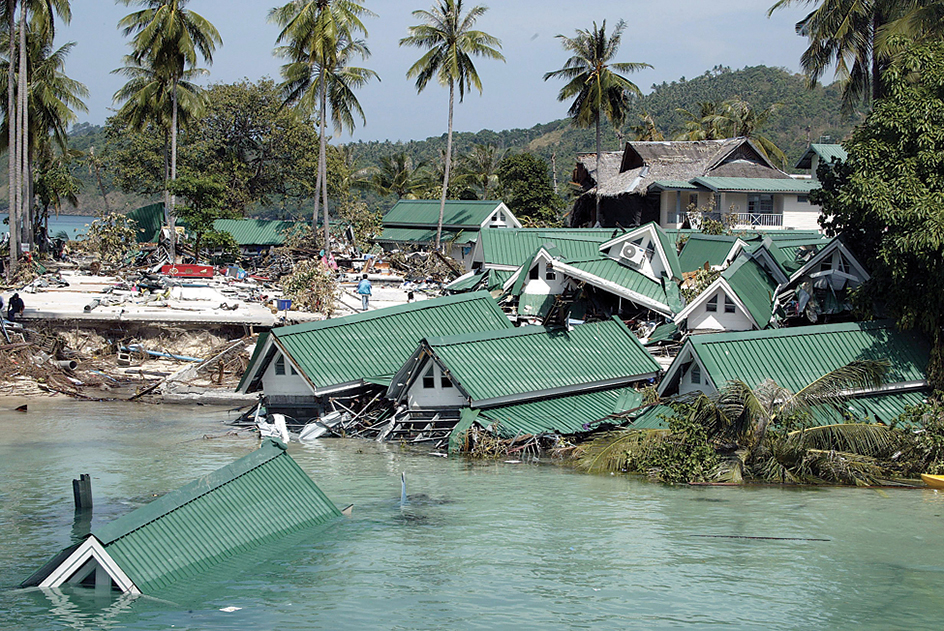
A new era.
Asia still faces many problems in addition to natural disasters. Millions of people in Asia are poor and illiterate. Disputes between peoples continue to threaten peace in many areas. Despite these problems, much of Asia entered a new era of development beginning in the late 1900’s.
Parts of East Asia and Southeast Asia have progressed rapidly. In the 1990’s, some of these states, including Singapore, South Korea, and Taiwan, became known as “Asian tigers” because their economies were so strong. These economies are based largely on high-technology industries and businesses, such as computer manufacturing. In the 2000’s, reforms in the world’s two most populous nations, China and India, stimulated rapid economic growth. In Southwest Asia, Israel developed a strong economy, and earnings from oil greatly improved the economies of other nations. In 2020, the 10 members of ASEAN along with Australia, China, Japan, South Korea, and New Zealand formed the Regional Comprehensive Economic Partnership (RCEP) to encourage mutual trade.
Economic progress enables governments to build new schools and train new teachers in an effort to raise educational levels. Today, a larger percentage of Asians than ever before attend school for at least a few years.
Along with its benefits, economic development also brings challenges. Rapid economic growth and industrialization have caused high levels of environmental pollution, especially in South and East Asia. Economic progress in Asia has also been uneven. In some nations, including Cambodia and Laos, development has been slow. In other nations, including Bangladesh, Sri Lanka, and Pakistan, progress has been mixed. Some parts of these countries have taken significant steps forward. Other parts remain poor.
Fewer Asians suffer malnutrition today, but millions still do not have enough to eat. The development of new high-yielding varieties of rice and wheat has helped reduce hunger in parts of the continent. 
In 2020, Asia and other regions of the world faced a public health emergency as the COVID-19 pandemic (global epidemic) spread rapidly. The sometimes-fatal respiratory disease originated in Wuhan, China, in late 2019. In January 2020, the Chinese government restricted travel in and out of Wuhan and several other cities to try to stop the disease from spreading. Despite these efforts, cases were soon reported in other Asian countries, and then in other nations throughout the world. Many governments in Asia took strong measures to slow the pandemic, such as closing national borders and canceling large gatherings. Some governments closed schools and nonessential businesses and ordered people to stay inside their homes. Nevertheless, many people became infected, and many died. Measures to contain the disease placed great strain on national economies throughout Asia.
Infection levels varied greatly among the different countries and regions of Asia. Vaccination programs began in the early months of 2021 in most Asian nations. However, many of the programs did not proceed rapidly enough to prevent surges in case numbers that began in the spring, especially as new strains developed that appeared to spread more quickly than the original version of the disease. The Asian countries with the highest numbers of confirmed cases included India, Indonesia, Iran, and Turkey. Russia also was among the nations with the most cases, but the majority of its cases were concentrated in urban areas in the European part of the country. New, more contagious variants continued to cause outbreaks in Asia into 2022. China, where COVID-19 first emerged, took aggressive lockdown measures to halt the spread of the disease. These measures kept case numbers low but caused economic damage and some social unrest. The government eased restrictions in late 2022, but this policy change led to a sharp increase in infection and death rates. By early 2023, more than 220 million people throughout Asia had been infected with the virus that causes COVID-19, and more than 1.5 million had died from the disease.
